Sites: news | india | latam | brasil | indonesia
Feeds: news | india | latam | brasil | indonesia
topic: Cetaceans
Social media activity version | Lean version
Education & research bring Rio’s dolphins back from the brink of extinction
- The Guiana dolphin (Sotalia guianensis) is one of the most common cetaceans in Brazil but also one of the most vulnerable, with numbers dwindling by up to 93% in the last 40 years.
- One of the worst affected regions is Guanabara Bay, in Rio de Janeiro, where Guiana dolphins face daily industrial contamination, sewage and noise pollution, causing chronic stress that leads to weakened immune systems and reproduction difficulties.
- A recently published study found high toxin concentrations in Guiana dolphins in neighboring Sepetiba Bay, which has significantly impacted the health of the population, the researchers found.
- Environmentalists are banking on research and education to help protect the species and consequently the marine environment. So far, a protected environment in Sepetiba Bay has helped stem dolphin mortality, and efforts are being made in Guanabara to clean up the bay, but more is required to restore and save the population.
Ancient giant river dolphin species found in the Peruvian Amazon
- Paleontologists discovered a fossilized skull of a newly described species of giant freshwater dolphin in the Peruvian Amazon, which lived around 16 million years ago and is considered the largest-known river dolphin ever found.
- The ancient creature, measuring 3-3.5 meters (9.8-11.5 feet), was surprisingly related to South Asian river dolphins rather than the local, living Amazon river pink dolphin and shared highly developed facial crests used for echolocation.
- The discovery comes at a time when the six existing species of modern river dolphins face unprecedented threats, with their combined populations decreasing by 73% since the 1980s due to unsustainable fishing practices, climate change, pollution, illegal mining and infrastructure development.
- Conservation efforts are underway, including the signing of the Global Declaration for River Dolphins by nine countries and successful initiatives in China and Indonesia, highlighting the importance of protecting these critical species that serve as indicators of river ecosystem health.
Irrawaddy dolphin death in Thailand’s Songkhla Lake underscores conservation needs
- As few as 14 critically endangered Irrawaddy dolphins remain in the world’s smallest freshwater population of the species, in southern Thailand’s Songkhla Lake.
- The recent death of one of the remaining few raised the alarm among cetacean specialists, who say more must be done to save the imperiled population.
- Teetering on the brink of extinction, the dolphins face a slew of threats from entanglement in fishing nets, depletion of fish populations, and deteriorating lake conditions due to increasing pressures from agriculture, industry and infrastructure development.
- Experts say a “once-in-a-lifetime” opportunity to reverse the dolphin’s trajectory of decline is on the horizon in the form of major funding for dolphin conservation linked to a road bridge megaproject, but they warn it will only be successful if government agencies can put aside their competing agendas.
Report: Rising slaughter of small whales and dolphins threatens ocean balance
- Killings of small whales, porpoises and dolphins are rising, with more than 100,000 of these marine mammals slaughtered each year, according to a new report from German and British NGOs.
- Many regions report increased catches driven by demand for dolphin meat as food and shark bait in areas impacted by economic crisis and dwindling fish stocks.
- Failure to address unsustainable exploitation of small cetaceans exacerbates ecological imbalance and heavy metal toxicity risks to humans who eat them, according to the report.
- Insufficient legislation and enforcement remain critical issues, according to the report, which calls for international collaboration and stronger protection measures.
Indus River dolphins’ survival is our responsibility (commentary)
- Indus River dolphins are distinguished by their elongated noses and small, nearly vestigial eyes.
- Once thriving in the lower parts of the Indus and its tributaries, their numbers have dwindled due to various environmental stresses.
- “Their story is not just about their survival but also about our responsibility to safeguard our planet’s diverse and increasingly vulnerable wildlife for future generations,” a new op-ed argues.
- This post is a commentary. The views expressed are those of the author, not necessarily Mongabay.
Nine countries sign global pact to protect endangered river dolphins
- Since the 1980s, the combined populations of river dolphin species have plummeted by 73%.
- With the Global Declaration for River Dolphins, 14 countries (six of them in Latin America) are expected to join forces to protect the six surviving species of this aquatic mammal that inhabit the world’s rivers and are under some category of threat. So far, nine of the governments involved have signed the declaration.
- The declaration comes at a critical moment for these animals. In September 2023, the death of more than 150 river dolphins in one of the most important lakes in Brazil raised international concern.
U.S. auctions off endangered whale habitat for oil and gas drilling
- On Dec. 20, the U.S. Department of the Interior’s Bureau of Ocean Energy Management (BOEM) held a lease sale to auction off oil and gas drilling rights in the Gulf of Mexico.
- Environmental groups and the U.S. Interior Department had tried to postpone this sale due to concerns about protecting the critically endangered Rice’s whale, a species whose key habitat overlaps with the lease sale areas.
- Scientists estimate there are fewer than 50 Rice’s whales left, and that the primary threat to the species is the oil and gas industry.
- While the lease sale went through without any protections for the Rice’s whale, environmental groups continue to explore legal and political avenues to ensure the species’ survival.
North Atlantic orcas reveal the troubling persistence of toxic ocean pollutants
- As the top predators in the ocean, killer whales suffer from the magnifying level of pollutants that build up in the marine food web.
- Scientists found that North Atlantic orcas feeding on marine mammals carry significantly higher levels of pollutants than orcas that eat fish.
- Levels of polychlorinated biphenyls in the orcas’ blubber are ten times higher than the toxic threshold for these dangerous household chemicals.
Dominica set to open world’s first reserve centered around sperm whales
- The tiny island nation of Dominica has announced that it will create a 788-square-kilometer (304-square-mile) reserve to protect endangered sperm whales.
- Most of the sperm whales that live off the coast of Dominica are part of the Eastern Caribbean Clan, which currently has a population of fewer than 300 individuals.
- Sperm whales in this region are threatened by fishing gear entanglement, pollution, boat strikes, and even tourism.
- The new reserve aims to protect whales by restricting activities such as fishing, vessel traffic and tourism, while not entirely banning them.
Fishing ban extension raises hopes for iconic Amazon pink river dolphin
- The Amazon river dolphin, or boto, is an integral feature of the rainforest’s biodiversity and culture, and is central to several Indigenous tales.
- Even though the dolphin isn’t fished for human consumption, it’s become endangered over the decades because fishers use its flesh as bait for catching piracatinga catfish.
- The Brazilian government earlier this year renewed a moratorium on fishing of piracatinga, first imposed in 2014, in the hope of saving the dolphin, but experts say fishers have just been ignoring the rule.
- The measure became even more relevant in October following the detection of more than 100 dead dolphins in an Amazon lake — experts suspect that the deaths are directly linked to the extreme drought affecting the region.
Iceland’s whaling paradox (commentary)
- As Iceland’s latest whaling season comes to a close, a heated debate continues over the ethics and sustainability of the country’s policy on these marine mammals.
- Filmmaker and activist Micah Garen — who co-directed the documentary “The Last Whaling Station” — shares his thoughts on what may be the nation’s last whaling season.
- “The paradox of whaling is the inherent contradiction between a utilitarian and Kantian world view. If you believe your choices matter, then ending whaling now is the only ethical, moral and philosophical choice we can make,” he argues.
- This post is a commentary. The views expressed are those of the author, not necessarily of Mongabay.
International outcry as Iceland lifts ban on what could be last whale hunt
- The Icelandic government has announced that commercial whaling will recommence following a two-month suspension of the activity, albeit with increased monitoring and stricter hunting regulations.
- The government temporarily banned whaling in June due to animal welfare concerns, but the ban expired on Aug. 31.
- The decision to restart whaling has drawn criticism from environmentalists and animal rights advocates.
- Only one company in Iceland currently has a whaling license, and it’s set to expire this year, with no guarantee the government will renew it for the coming years.
Keep it down: U.N. report lists ways to reduce ocean noise pollution
- A new report published by the U.N.’s Convention on the Conservation of Migratory Species of Wild Animals (CMS) outlines possible solutions to human-caused ocean noise that impacts marine life.
- It focuses on three main types of underwater noise: shipping, seismic air gun surveys, and pile driving.
- Lindy Weilgart, the report author, said she believes it’s essential to move toward finding solutions rather than only studying the impacts of human-caused ocean noise.
- An outside expert praised the report but also questioned the likelihood of the suggestions being followed, and argued that the noise impacts of wind turbines have not been fully considered.
‘No future’: Iceland cancels whale hunt over animal welfare concerns
- Citing animal welfare concerns, Iceland has suspended its whale hunting season until Aug. 31.
- This decision follows the release of a government-commissioned independent report that found that many whales suffer immensely after being harpooned.
- Iceland had been set to kill around 200 fin whales, up from the 148 it killed in 2022.
How do you study one of the world’s rarest whales?
- Researcher Dana Wright is one of a handful of scientists studying one of the world’s rarest creatures, the North Pacific right whale.
- With about 500 individuals remaining, and its eastern population that swims off the coast of North America totaling perhaps 30 individuals, it’s so rare that in a decade of research, she has yet to see a living individual of the population, though her colleagues have.
- How does one study a creature that’s so hard to document? With tools like bioacoustics, for example, and Wright has listened to tens of thousands of hours of recordings to aid the conservation of these endangered animals.
- The team continues to develop new approaches to solving the mystery of these whales’ migratory patterns and biology with a goal of identifying — and then protecting — the location of their winter calving grounds.
Scientists and fishers team up to protect Bolivian river dolphin
- Hunting, fishing, pollution and degradation and loss of habitat are the main threats facing the Bolivian river dolphin, a species of river dolphin that is found in 10 protected areas in the country.
- For almost three decades, scientists have involved local commercial fishers in an effort to document and monitor the landlocked country’s sole cetacean.
- A team of reporters joined them in sailing 450 kilometers (280 miles) upriver during the most recent population census.
Potential impact on whales overlooked as deep-sea mining looks set to start, experts say
- Scientists say future deep-sea mining activities could impact cetaceans through noise pollution, which could interfere with their communication processes.
- According to an opinion piece, a team of experts say assessments of deep-sea mining impact have focused on species associated with the seabed rather than transitory megafauna that inhabit the proposed mining areas, and that urgent research is needed to understand the potential impact on cetaceans.
- However, a mining company says it is evaluating the potential impact of its proposed operations on cetaceans through the gathering of acoustic data during its recent mining test in the CCZ, which it will combine with three years of environmental baseline data.
- Deep-sea mining in international waters may begin later this year after the Pacific island nation of Nauru, which sponsors a subsidiary of a Canadian mining firm, requested accelerated approval of its mining operation.
U.S. refuses calls for immediate protection of North Atlantic right whales
- The U.S. government has rejected requests to implement emergency measures to protect critically endangered North Atlantic right whales from vessel collisions during the species’ calving season, which takes place between November and April each year.
- Some protections for right whales are already in place, but experts say urgent modifications are needed to protect pregnant females, lactating mothers and calves.
- There are only about 340 individual North Atlantic right whales left in the world, and birth rates are low.
- The National Marine Fisheries Service has proposed similar protections for right whales, including the enforcement of speed limits across more extensive areas of the ocean and for the rules to apply to more vessels — but charity workers are cautious about the outcome of this proposal.
That dead whale on the beach? Let it be, study says. Or at least don’t blow it up
- When marine mammals wash ashore, government agencies often set about removing the carcass.
- Strategies include burying the body, transporting it to a landfill or incinerator, towing it out to sea, and in at least one misguided case, detonating it.
- But in removing dead, stranded cetaceans from beaches, we may be overlooking the environmental benefits they offer, according to a new study.
- The researchers recommend leaving carcasses to rot in place whenever possible, where the environmental benefits they offer include supporting communities of scavengers, such as threatened species like polar bears and California condors.
Top 15 species discoveries from 2021 (Photos)
- Science has only just begun to find and describe all of the species on Earth; by some estimates, only 20% have been described.
- This year, Mongabay reported on newly described species from nearly every continent, including an Ecuadoran ant whose name broke the gender binary, an acrobatic North American skunk, an Australian “killer tobacco,” a fuzzy orange bat from West Africa, tiny screech owls from Brazil, and more.
- Though a species may be new to science, that doesn’t mean it has not yet been found and given a name by local and Indigenous communities.
El Niño takes a toll on southern right whales in the Atlantic Ocean
- Southern right whale populations near Argentina have suffered surprising losses during recent El Niño years.
- Intense warmings in 1997-98 and 2015-16 each killed 4 to 5 percent of right whales in the southwest Atlantic Ocean, researchers estimate.
- If El Niño events worsen, models suggest the encouraging recovery of southern right whales could stall or even reverse.
If marine noise pollution is bad, deep-sea mining could add to the cacophony
- A new report suggests that the noise pollution produced by deep-sea mining activities could have far-reaching effects on the marine environment, from surface to seafloor.
- While there are many studies that measure the impacts of noise pollution on marine life, more research is needed to fully understand how sound from deep-sea mining could affect the ocean.
- Due to the paucity of information, experts say a precautionary approach to deep-sea mining noise is required and that clear regulations must be put into place by the International Seabed Authority.
- While deep-sea mining has yet to begin, a subsidiary of Canada-based The Metals Company plans to start mining in less than two years.
Project maps soundscape of human noise in northern Adriatic and impact on marine life
- The bottlenose dolphin population of Croatia’s Lošinj archipelago is increasingly faced with problems from noise disturbance produced by boats, particularly in the summer tourist season.
- Noise pollution is known to impact a wide range of marine species, from turtles to tuna to cetaceans, but its long-term effects are still little-understood.
- The SOUNDSCAPE project that started in 2019 in the northern Adriatic Sea, between Italy and Croatia, is trying to better understand the problem at the regional level and identify solutions.
Faroe Islands to evaluate traditional hunt after slaughter of 1,400 dolphins
- The killing of 1,428 Atlantic white-sided dolphins in the Faroe Islands has sparked outrage among local people and attracted international criticism over the legitimacy of such hunts.
- The hunt was reportedly unauthorized and in violation of local Faroese law.
- In response, the Faroese prime minister announced that the government will evaluate the recent dolphin hunt as well as the tradition’s place in society.
Stranded dugong in Indonesia reportedly cut up for traditional medicine
- Two dugongs stranded earlier this week on an island in eastern Indonesia, but only one survived and returned to the sea.
- With conservation authorities unable to go to the site due to COVID-19 restrictions, some locals reportedly cut up the dead dugong’s body and distributed the parts for use in traditional medicine.
- Dugongs are a protected species under Indonesian law, and possession of their body parts, even after a natural death, is a crime.
- Strandings of marine animals, particularly sea mammals, are common in Indonesia as its waters serve as both a habitat and an important migratory route for dozens of species.
Hunger, disorientation blamed for pilot whale mass stranding in Indonesia
- Indonesian officials have announced their findings into the cause of the mass stranding and death of 52 short-finned pilot whales earlier this year.
- They cited inflammation in the alpha whale’s echolocation organ as the cause of the stranding, and hunger and lung damage as the causes of death.
- The Indonesian fisheries ministry has called for more necropsies to be done more regularly after strandings to better understand these events and inform policies on how to handle them.
- Whale and dolphin strandings are common in Indonesia, which has the longest coastline in Asia and whose waters serve as both a habitat and an important migratory route for dozens of cetacean species.
‘Minke whales for dinner’: Norway’s controversial whale hunt is still on
- Norway has announced that it will target up to 1,278 common minke whales in its upcoming whaling season, which is the same quota as the past two years.
- While the Norwegian government says its whaling program is sustainable, some scientists, conservationists and animal welfare experts counter this claim.
- These anti-whaling advocates also point to a growing body of evidence that suggests that whales play a pivotal role in regulating the marine ecosystem, and that whales are worth more alive than dead.
- There has been a global moratorium on commercial whaling since 1986, but Norway chooses to reject this ban.
When Chinook salmon is off the menu, other prey will do for endangered orcas
- A new study has found that endangered southern resident killer whales mainly consume endangered Chinook salmon, but will broaden their diet when this species isn’t available.
- The researchers obtained data through prey and fecal waste collected from resident killer whales over a 13-year period.
- Efforts to reinstate Chinook salmon populations through hatchery efforts can play an important role in supporting resident killer whale populations, although these programs need to be carefully managed to ensure that stocks are diverse, the study suggests.
Only 1 of 52 pilot whales survives mass stranding in Indonesia
- Two of the three whales that initially survived later became stranded again and died.
- Researchers are trying to determine the cause of the mass stranding, just the latest one in Indonesia.
Fewer than 100 of these giant whales make up a newly described species
- In January scientists announced the designation of a new whale species in the Gulf of Mexico they named Rice’s whale (Balaenoptera ricei).
- The team previously collected genetic samples of the whales but didn’t confirm the new species until they had a complete skeleton.
- Only between 33 and 100 individual members of the species exist, researchers estimate. The species is listed as endangered in the U.S.
- The Gulf of Mexico is fraught with many human-made threats to the whales’ survival, including dense ship traffic, oil and gas exploration, and marine trash.
Rare beaked whale sighting could be a world first for the species
- Researchers looking for elusive beaked whales in the South China Sea believe they spotted a pair of either the ginkgo-toothed or Deraniyagala’s beaked whale.
- Although they collected extensive observational data, they could not confirm the whales’ species without DNA samples.
- The sighting is nevertheless important: Knowledge of both beaked whale species has been limited to what researchers have learned from a handful of stranded whale carcasses and unconfirmed sightings.
- The encounter likely represents either the first ever live sighting of the ginkgo-toothed beaked whale (Mesoplodon ginkgodens), or the first live sighting of the nearly identical Deraniyagala’s beaked whale (Mesoplodon hotaula) in the western Pacific Ocean.
Whale of a find: Scientists spot beaked whale believed to be a new species
- Scientists on board a Sea Shepherd vessel say they found a new species of beaked whale near the San Benito Islands off Mexico’s Pacific coast.
- The species differs visually and acoustically from other beaked whales species, according to the researchers.
- The team took photographs, video recordings and acoustical recordings of the species, and also performed environmental genetic sampling to help confirm the existence of a new species.
- However, other experts say that detailed descriptions of the animals’ physical features and skeletal structure are needed before a new species can be accurately identified.
Can whales and dolphins catch COVID-19 from wastewater? It’s murky
- A new study identifies 15 marine mammal species, including whales, dolphins, seals and sea otters, that could be susceptible to the SARS-CoV-2 virus through contact with wastewater.
- According to the researchers, vulnerable populations of marine animals that congregate near wastewater discharge sites face elevated risks.
- To minimize these risks, the researchers suggest closely monitoring vulnerable populations for possible infection and vaccinating if necessary, and also restricting access to at-risk captive marine mammals.
- However, other experts say it is implausible for marine animals to get sick through contact with wastewater since virus transmission through water is unlikely.
Whale zone ahead: A cetacean speed trap tags ships going over the limit
- North Atlantic right whales, a critically endangered species with fewer than 366 remaining individuals, face two main threats: fishing gear entanglements and ship strikes.
- Many ships do not obey voluntary or mandatory speed restrictions in areas where North Atlantic right whales are present, raising the risk of fatal collisions.
- A new tool called Ship Speed Watch provides information on vessels that are not obeying speed restrictions.
- Conservationists say they hope it will help build awareness and strengthen regulations surrounding ship speeds.
481 and counting: Norway’s whaling catch hits four-year high
- New data show that Norway has killed 481 minke whales so far this year, a number that surpasses the toll from the past three years.
- Norway continues its commercial whaling operation despite the International Whaling Commission placing a global moratorium on commercial whaling in 1982.
- While some whale meat and whale products are sold within Norway, the country also exports it to countries like Japan, Iceland and Denmark’s Faroe Islands.
- Whaling industry representatives say that whale meat sales have gone up in Norway during the COVID-19 pandemic, while conservationists and animal welfare advocates say that most Norwegians are not interested in consuming whale meat.
Narwhals beware: Killer whales are on the rise in the Arctic
- Climate change has led to dramatic ice loss in the Arctic, allowing killer whales to access parts of the Canadian Arctic they previously couldn’t.
- A new study found that a population of 136 to 190 killer whales spent the warmer summer months in Canada’s northern Baffin Island region between 2009 and 2018, and preyed on as many as 1,504 narwhals each season.
- While the overall narwhal population isn’t in immediate danger, a steady influx of killer whales could lead to ecosystem transformation through a top-down trophic cascade, according to the study.
Caught on camera: Rare finless porpoises sighted in Hong Kong waters
- Video of the Indo-Pacific finless porpoise, a rare and elusive species, was recently captured by drone off the coast of South Lantau Island in Hong Kong.
- A 2002 study estimated there to be about 220 finless porpoises left in the Hong Kong area, while more recent reports give a slightly higher number.
- In 2019 alone, there were at least 42 strandings of finless porpoises in Hong Kong, which has raised concerns about the current population in that region.
- The finless porpoise has a large range across Hong Kong, Southeast Asia, India and the Middle East, but the elusive nature of the species makes it hard to survey.
Economists put a price tag on living whales in Brazil: $82 billion
- Last year, a team of four economists published a report suggesting that living whales have a high market value for the services they provide in terms of ecotourism, carbon sequestration, and fishery enhancement. Each whale is worth about $2 million USD, they estimated.
- The economists, in collaboration with two conservation organizations, Instituto Baleia Jubarte and the Great Whale Conservancy, estimated that Brazil’s whale population is worth $82 billion.
- The team says it hopes the notion of valuing whales in Brazil, as well as in other coastal nations, can help protect whales from common fatalities like ship strikes, fishing gear entanglement, and deliberate hunting.
Iceland won’t be killing any whales this year
- An Icelandic whaling business, IP-Utgerd, has announced that it will stop whaling altogether, while the largest whaling company in the country, Hvalur hf., has halted its whaling operations for the second year in a row.
- IP-Utgerd and Hvalur continued to whale in spite of the International Whaling Commission (IWC) placing a global moratorium on whaling in 1986.
- Conservationists say they hope that whaling ends permanently in Iceland, although it’s possible that Hvalur will resume hunting whales again in the near future.
Russia lists Caspian seals and orcas as endangered species after ‘whale jail’ controversy
- Mammal-eating orcas and Caspian seals were recently listed as endangered species by Russia, following the “whale jail” debacle that raised international concerns.
- This is the first time in more than 20 years that the Russian government has updated its red book of locally threatened species, so conservationists and animal advocates see this latest move as an enormous victory.
- This is also the first time that Russian authorities have acknowledged that there are two ecotypes of orcas — mammal-eating orcas and fish-eating orcas.
- Experts say they believe the new red book listings will put a halt to the international trade of orcas captured in Russian waters, although belugas may still be trafficked.
Listening to marine mammals is helping scientists understand Arctic impacts of climate change
- A 4-year bioacoustic study of marine mammals in the northern Bering Sea will help scientists track the impacts of global climate change on Arctic ecosystems.
- A team of researchers studied how seasonal variation in sea surface temperatures and sea ice extent affect populations of five species of endemic Arctic marine mammals: bearded seals (Erignathus barbatus), beluga whales (Delphinapterus leucas), bowhead whales (Balaena mysticetus), ribbon seals (Histriophoca fasciata), and walrus (Odobenus rosmarus).
- The researchers captured more than 33,000 individual vocalizations from whales, walruses, and seals over the course of the study, which was conducted between 2012 and 2016. They say that their findings showed consistent seasonal distribution and movement patterns for most of the studied species, supporting previous scientific and traditional knowledge about the distribution of marine mammals in the northern Bering Sea, while providing more precise data than was previously available.
Baby whale wears a camera, reveals its travel and nursing behavior: video
- A video taken by a camera carried by a baby whale shows underwater nursing behavior from the calf’s perspective.
- The CATS Cam camera used in the filming incorporates multiple environmental sensors, such as depth and temperature, as well as movement and acceleration by the calf.
- The unusual perspective may help researchers better understand the nursing process of a baby whale, including surfacing to breathe while its mother remains underwater and suckling from mammary slits on each side of its mom.
Canada passes ‘Free Willy’ bill to ban captivity of all whales, dolphins
- On June 10, Canada’s House of Commons passed a bill that bans the practice of keeping cetaceans (whales, dolphins and porpoises) in captivity in the country.
- Bill S-203 also prohibits breeding of the animals and collecting reproductive materials from them. The only exceptions to these provisions will be in cases of rescues and rehabilitation, licensed scientific research, or “in the best interests of the cetacean’s welfare.”
- The legislation, also known as the “Free Willy” bill, allows Vancouver Aquarium and Marineland in Niagara Falls, the only two facilities in Canada that still house cetaceans, to continue to keep their animals as long as they do not breed or bring in any new individuals.
Recently discovered Brazilian river dolphin’s calls could help us understand evolution of marine mammal communication
- Until recently it was believed that the solitary nature of Araguaian dolphins meant that they wouldn’t have much use for communication. But scientists have now documented hundreds of sounds made by the dolphins — and they say that these vocalizations could help us better understand the evolution of underwater communication among marine mammals.
- Using underwater cameras and microphones to record interactions between the dolphins, researchers recorded 20 hours of vocalizations, which they classified into 13 different types of “tonal sounds” and 66 types of “pulsed calls.” In total, they identified 237 distinct types of calls.
- The most common sounds the dolphins made were “short two-component calls,” the researchers report in the study. About 35 percent of these calls were made by calves while reuniting with their mothers, which suggests that the calls are an important component of mother-calf communication.
Indonesia trains its citizens to deal with sea-mammal strandings
- The waters around Indonesia serve as both a habitat and an important migratory route for dozens of species of whales, dolphins and porpoises.
- These cetaceans, however, are often found dead on Indonesian beaches, or alive but unable to return to deeper waters themselves.
- To prevent the deaths of marine mammals that strand themselves on its shores, the government has sought to establish a network of first responders equipped with the knowledge and training to deal with problem.
- Experts say what’s more important than providing an adequate response is to reduce the threats that lead to the strandings, including by improving the management of marine habitats and tackling pollution in the sea.
Tear down the dams: New coalition strives to enshrine rights of orcas
- A new coalition of scientists, indigenous peoples, community groups and lawyers is pushing for legal recognition of the rights of an endangered orca population living in the Salish Sea.
- The population, known as the Southern Resident Killer Whales, numbers just 75 individuals, down from 98 in 1995.
- The orcas are imperiled by noise and chemical pollution, the impending construction of Canada’s Trans-Mountain pipeline, and, most of all, severe salmon shortages caused by the damming of the rivers that feed into the sea.
Latam Eco Review: Shark ceviche, bat-friendly tequila, and protein-rich worms
 Recent top stories from our Spanish-language service, Mongabay-Latam, revealed Peruvians’ hidden shark diet, new species in Colombia’s Chiribiquete National Park, dire predictions from Mexico’s “Batman,” and more. Peruvians are eating shark and don’t know it Three out of four Peruvians recently surveyed were found to have eaten shark meat without knowing it. The problem stems […]
Recent top stories from our Spanish-language service, Mongabay-Latam, revealed Peruvians’ hidden shark diet, new species in Colombia’s Chiribiquete National Park, dire predictions from Mexico’s “Batman,” and more. Peruvians are eating shark and don’t know it Three out of four Peruvians recently surveyed were found to have eaten shark meat without knowing it. The problem stems […]
Investigation reveals illegal trade cartels decimating vaquita porpoises
- An investigation has exposed new details of the illegal trade in the totoaba fish’s swim bladder.
- Totoaba swim bladders are used in traditional medicine and can fetch thousands of dollars per kilogram in Chinese markets.
- Illegal fishing for totoaba is the primary reason vaquita porpoises are headed toward extinction.
- Elephant Action League’s investigation has identified the people involved and the routes they use to smuggle the bladders to buyers in China.
Ice-free passage for ships through the Arctic could cause problems for marine mammals
- A new study suggests that increased ship traffic in the Arctic, as ice there melts due to climate change, could disturb marine mammal species.
- In their assessment of 80 subpopulations living along the Northwest Passage and Russia’s Northern Sea Route, 42 are likely to be affected by a greater number of commercial ships, researchers found.
- The team suggests that mitigation measures, such as those employed in other parts of the world to protect North Atlantic right whales, could be effective.
Shark fisheries hunting dolphins, other marine mammals as bait: Study
- Global shark fisheries have for decades engaged in the deliberate catch of dolphins, seals and other marine mammals to use as bait for sharks, a new study has found.
- The researchers found the practice picked up when prices for shark fin, a prized delicacy in Chinese cuisine, went up from the late 1990s onward.
- The researchers have warned that the targeting of these species could hit unsustainable levels, and have called for more studies into the species in question as well as better enforcement of existing law protecting marine mammals.
More than 800 totoaba swim bladders confiscated by Mexican authorities in smuggling busts
- In two separate arrests of Chinese nationals, Mexican police confiscated more than 800 swim bladders from a large fish called the totoaba.
- Totoaba swim bladders are used in traditional medicine and can fetch thousands of dollars per kilogram in Chinese markets.
- Fishing for totoaba has also pushed a small porpoise called the vaquita close to extinction. One recent estimate puts the number of animals left in the wild at 12.
Company to probe for minerals close to Mekong River dolphin habitat
- The Phnom Penh Post reported today that Medusa Mining, an Australian company, plans to invest $3 million over four years in explorations for gold, copper, oil, gas and precious stones in tributaries of the Mekong River in Cambodia.
- Irrawaddy river dolphins, an endangered species of cetacean, live in the Mekong adjacent to the areas slated for exploration.
- Only about 80 dolphins remain in the Mekong River, and, although their numbers are on the rise, they face threats from gillnets, dams, boat traffic and water pollution, which could be exacerbated by mining activity.
First vaquita ‘rescued’ in bid to save the porpoise from extinction
- A project to save a small, critically endangered porpoise called the vaquita in the Gulf of California succeeded in capturing a 6-month-old calf in mid-October.
- Veterinarians noticed signs of stress, so they made the decision to release it back into the wild, rather than keep it in a sea pen.
- The project’s leaders are heartened by the experience and hope to round up more vaquita to keep them safe from the still-present threat of gillnet entanglement in the northern Sea of Cortez.
Hard but worth it: researchers fight invasives on Subantarctic islands (commentary)
- Sealers and subsequent human visitors to the Southern Ocean’s windswept islands brought with them a variety of invasive species, such as mice, rats, cats, sheep, and goats, that have wrought havoc on the islands’ native wildlife and ecosystems.
- On Marion Island, midway between South Africa and Antarctica, researchers and conservationists completed the largest successful cat eradication on an island in history in 1993.
- Marion Island’s wildlife has largely rebounded from the sealers and cats, but invasive mice continue to take a toll.
- The author points to other recent successful eradications of invasive species on Subantarctic islands and argues that they are a wise investment with benefits for wildlife as well as research into the region’s ecology and the effects of climate change. The views expressed are the author’s own, not necessarily Mongabay’s.
Leonardo DiCaprio teams up with Mexico’s president and wealthiest individual to save the vaquita
- A report by the International Committee for the Recovery of the Vaquita released in February found that there are as few as 30 vaquita left in the Upper Gulf of California, the small marine cetacean species’ only known range.
- Despite the ban adopted by Mexico two years ago, unlawful use of gillnets remains widespread in the Upper Gulf of California, where they’re used to catch totoaba, a fish whose swim bladder is much prized by practitioners of traditional Chinese medicine.
- Both the Carlos Slim Foundation and the Leonardo DiCaprio Foundation will reportedly be backing the agreement by committing funds to local development projects and alternative fishing gear options.
- In order to further crack down on illegal fishing activities, the agreement also includes a prohibition on night fishing and measures to tighten entry and exit controls in the vaquita reserve, according to the AP.
Underwater cameras let scientists dive beneath the surface with dolphins
- Using custom-made, noninvasive underwater cameras that they attached directly to the dolphins’ bodies, researchers with the University of Sydney and the University of Alaska Southeast captured more than 500 minutes of footage, allowing them to observe behaviors that humans rarely have the privilege of witnessing.
- The study’s lead author, Heidi Pearson, a dolphin specialist and assistant professor of marine biology at the University of Alaska Southeast, said that the cameras provide such a fine degree of information that they could open up whole new avenues of research for protecting endangered species.
- While the cameras themselves may represent the cutting-edge in technology, Pearson and team attached them to eight wild dusky dolphins off the coast of New Zealand with the aid of decidedly low-tech implements: a long pole and some Velcro pads.
Rare beaked whale filmed underwater for the first time
- True’s beaked whale is difficult to spot at sea, and remains a poorly studied species.
- By analyzing stranding data and live sightings of the whale, researchers confirm that the Azores and Canary Islands may actually be a hotspot for studying the natural behavior of the species.
- For the data-scarce whale species, live sightings and video recordings are highly valuable because they add to information that helps identify a species accurately.
- This in turn can help scientists monitor the status of their populations and protect them.
How acoustic monitoring gave us a last chance to save the vaquita
- Monitoring the vaquita’s vocalizations has allowed scientists to closely and accurately monitor the species’ unfortunate decline.
- Illegal fishing for totoaba is the biggest threat to the vaquita. They are killed as bycatch, drowning in nets meant for the fish.
- Conservationists say the next step is to capture vaquitas for captivity, a highly controversial plan with major risks.
Audio: An in-depth look at Mongabay’s collaboration with The Intercept Brasil
- Branford is a regular contributor to Mongabay who has been reporting from Brazil since 1979 when she was with the Financial Times and then the BBC.
- One of the articles in the series resulted in an official investigation by the Brazilian government before it was even published — and the investigators have already recommended possible reparations for an indigenous Amazonian tribe.
- We also round up the top news of the past two weeks.
There are now just 30 vaquita left in the wild
- According to a recent report by the International Committee for the Recovery of the Vaquita (CIRVA), there are now just 30 vaquita left in the Upper Gulf of California, the body of water that separates Baja California from mainland Mexico and the species’ only known range.
- About 49 percent of the remaining vaquita population was lost between 2015 and 2016, CIRVA found.
- The primary cause of death for the vaquita (Phocoena sinus) is becoming entangled in gillnets used to catch totoaba, a giant Mexican fish whose swim bladders are much in demand, especially in China.
Scientists say current plan to protect the vaquita will not save the species
- Between 2011 and 2015, the vaquita population decreased by an estimated 80 percent as a result of bycatch in gillnets set illegally to capture totoaba. There are believed to be fewer than 60 left.
- After the White House meeting, President Nieto agreed to permanently ban gillnets in the vaquita’s range (an emergency 2-year ban was adopted in May 2015), in addition to other measures.
- But a team of Mexican and American researchers determined that, while the temporary gillnet ban now in place and the proposal to switch to new trawl gear will likely alleviate the immediate bycatch problem threatening the vaquita, the current conservation plan “neglects local livelihoods, the traditions and heritage of the community, the ecological integrity of the area and increases dependence on fishing subsidies.”
Time running out to save world’s most endangered porpoise, environmentalists warn
- The critically endangered vaquita (Phocoena sinus) is often referred to as “the world’s most endangered cetacean species,” but not because of any direct threat, like overfishing.
- The most severe threats to the remaining vaquita is incidental death due to becoming entangled in fishing gear such as gillnets or being killed by commercial shrimp trawlers.
- But it is China’s demand for swim bladders from a giant Mexican fish called the totoaba (Totoaba macdonaldi) that is really putting the species at the greatest risk, and the upcoming Conference of the Parties to the Convention on Trade in Endangered Species of Fauna and Flora (CITES) is a major opportunity to take the necessary steps to protect the vaquita.
Humpback whales rescue seals and other animals from killer whales
- After reviewing over 100 interactions between humpback whales and killer whales, researchers have found that not only do humpbacks aggressively protect their own calves from killer whales, they also tend to rush to the aid of other distraught species like seals.
- A humpback might be able to fight a killer whale because of its gigantic size and massive flippers, researchers say.
- One possible reason for the humpbacks’ seemingly selfless act could be to increase the chance of protecting their own calves from killer whales. Sometimes this ends up protecting other species.
Mexico bans gillnets to protect rare vaquita porpoise
- From September, Mexico will permanently ban the use of gillnets throughout the range of vaquita porpoise in the upper Gulf of California.
- Night fishing will also be phased out by the end of this year.
- Fishermen will have to use specific landing and unloading sites to help enforce protection measures, according to Mexico’s National Aquaculture and Fisheries Commission.
Hundreds of baby dolphin deaths linked to BP oil spill
- Between 2010 and 2014, more than a thousand common bottle-nosed dolphins washed ashore in the Gulf of Mexico.
- A large proportion of the dead dolphins were perinates: late-term dolphins that had died inside the womb or very young newborns.
- Exposure to the 2010 BP oil spill could have caused late-term abortions of in-utero dolphins, or early death of newborns, researchers conclude in a new paper published in Diseases of Aquatic Organisms.
Want to end illegal fishing? Make all ships trackable, say researchers
- Some ships already carry automatic identification systems (AIS) — devices that transmit publicly available data about the vessel’s identity, position, and course. But commercial fishing vessels are exempt in many jurisdictions.
- A group of researchers argues that new policies, including mandating that commercial fishing vessels carry AIS devices, are needed to curb illegal fishing, especially over vast stretches of ocean.
- Making vessels trackable will also help prevent collisions with whales and enable officials to monitor undersea mining, among other benefits, the researchers argue.
‘Aquatic cocaine’: Illegal trade in swim bladders of rare fish puts world’s rarest porpoise at risk of extinction
- Dried swim bladders of totoabas (also called “maw”) have been dubbed “aquatic cocaine” due to the high prices they fetch mainly in Chinese markets.
- Illegal trade in the swim bladder of the totoabas, has placed not just the totoabas but also the world’s smallest and rarest marine mammal, the vaquita, at risk of extinction, according to report.
- EIA’s investigation has also identified numerous online platforms, such as Facebook, that actively trade in fish maw, including discussions on best routes to smuggle maws into Hong Kong and China.
Preservatives from cosmetics build up in the bodies of far-flung marine mammals
- Scientists have detected parabens, a common cosmetic preservative, in marine mammals from coastal areas of the United States.
- The chemical concentrations were highest in coastal animals like dolphins and sea otters, but also showed up in polar bears in remote regions.
- Researchers don’t yet know how toxic these chemicals are, but parabens can disrupt hormones in the body.
BP oil spill may be causing failed pregnancies in dolphins
- During a health assessment of bottlenose dolphins in 2011 following BP oil spill, researchers found that 10 of 32 sampled dolphins were pregnant.
- Researchers monitored the dolphins for next four years and found that only two produced viable calves.
- Researchers even observed one female dolphin pushing her dead baby in the water.
Population of Maui’s dolphins slips below 50
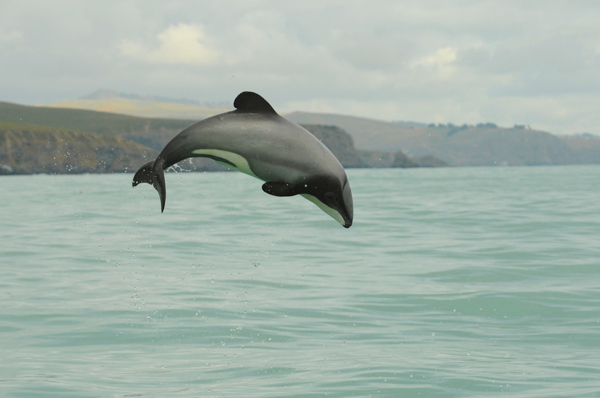 A New Zealand dolphin, one of whose two subspecies, the Maui’s dolphin, is critically endangered with a quickly diminishing population. Photo credit: Steve Dawson/NABU International Foundation for Nature. Maui’s dolphins (Cephalorhynchus hectori maui) are edging closer to extinction. Strikingly marked, with a dark, rounded dorsal fin that has been likened to a Mickey Mouse ear, […]
A New Zealand dolphin, one of whose two subspecies, the Maui’s dolphin, is critically endangered with a quickly diminishing population. Photo credit: Steve Dawson/NABU International Foundation for Nature. Maui’s dolphins (Cephalorhynchus hectori maui) are edging closer to extinction. Strikingly marked, with a dark, rounded dorsal fin that has been likened to a Mickey Mouse ear, […]
Vaquita porpoises down to ‘way less than 100,’ Mexican agents shoot fisherman while enforcing new protected area
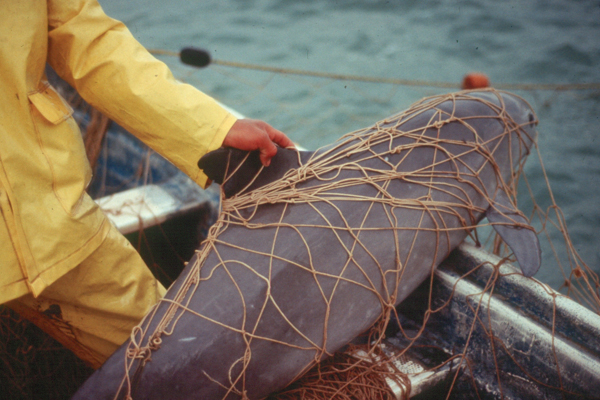 A fisherman hauls up a critically endangered vaquita porpoise accidentally entangled in his net in 2008. Entanglement in fishing gear threatens the species with extinction. Photo credit: Omar Vidal. With fewer than 100 individuals alive and dropping fast, the vaquita porpoise is just a swish of the tail away from extinction. In April, alerted by […]
A fisherman hauls up a critically endangered vaquita porpoise accidentally entangled in his net in 2008. Entanglement in fishing gear threatens the species with extinction. Photo credit: Omar Vidal. With fewer than 100 individuals alive and dropping fast, the vaquita porpoise is just a swish of the tail away from extinction. In April, alerted by […]
Last ditch: Mexico finally gets serious about saving the vaquita
 Vaquitas (Phocoena sinus) are more solitary than other cetacean species, but are sometimes found in small groups. Photo by: Paula Olson, NOAA. There are likely less than 100 vaquita (Phocoena sinus) on the planet. Found only in the northern pocket of the Sea of Cortez in Mexico, the vaquita is a tiny, shy porpoise that […]
Vaquitas (Phocoena sinus) are more solitary than other cetacean species, but are sometimes found in small groups. Photo by: Paula Olson, NOAA. There are likely less than 100 vaquita (Phocoena sinus) on the planet. Found only in the northern pocket of the Sea of Cortez in Mexico, the vaquita is a tiny, shy porpoise that […]
Is there hope for the vaquita? IUCN calls for action to save world’s smallest, rarest porpoise
 Fishing industry propelling tiny cetacean to extinction Since the baiji was declared extinct in the early aughts, the vaquita has taken its unenviable position as the world’s most threatened cetacean. The tiny porpoise currently numbers around 100, with accidental entanglement in gillnets primarily responsible for its decline. In response, the IUCN recently issued a statement […]
Fishing industry propelling tiny cetacean to extinction Since the baiji was declared extinct in the early aughts, the vaquita has taken its unenviable position as the world’s most threatened cetacean. The tiny porpoise currently numbers around 100, with accidental entanglement in gillnets primarily responsible for its decline. In response, the IUCN recently issued a statement […]
Norway slaughters over 700 whales this season
.600.jpg) Norway has its biggest minke whaling season in over 20 years. As of late August, Norway has killed 729 northern minke whales (Balaenoptera acutorostrata) during its annual whaling season, the highest number taken since 1993. Norway continues whaling by having filed an “objection” under the International Whaling Commission (IWC), which has banned whaling worldwide aside […]
Norway has its biggest minke whaling season in over 20 years. As of late August, Norway has killed 729 northern minke whales (Balaenoptera acutorostrata) during its annual whaling season, the highest number taken since 1993. Norway continues whaling by having filed an “objection” under the International Whaling Commission (IWC), which has banned whaling worldwide aside […]
California blue whales recover to historical levels
 California or North Pacific Blue Whales can exceed 100 feet (30m) long and weigh 190 tons. Photo courtesy of Gilpatrick/Lynn/NOAA The population of blue whales in the Eastern Pacific has recovered to 97 percent of historic levels decades after Earth’s largest animal was nearly driven to extinction in some places due to the whaling industry, […]
California or North Pacific Blue Whales can exceed 100 feet (30m) long and weigh 190 tons. Photo courtesy of Gilpatrick/Lynn/NOAA The population of blue whales in the Eastern Pacific has recovered to 97 percent of historic levels decades after Earth’s largest animal was nearly driven to extinction in some places due to the whaling industry, […]
Coastal wildlife paradise declared biosphere reserve in Argentina (PHOTOS)
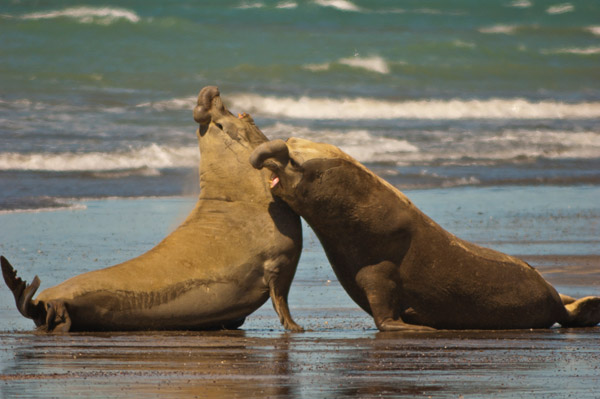 Southern elephant seals battle for mating rights. Photo by: G. Harris/WCS. Conservationists are celebrating the announcement that UNESCO has dubbed Argentina’s Península Valdés a biosphere reserve under the Man and Biosphere Program (MBA). A hatchet-shaped peninsula that juts out into the Southern Atlantic Ocean, the world’s newest biosphere reserve is home to a hugely-diverse collection […]
Southern elephant seals battle for mating rights. Photo by: G. Harris/WCS. Conservationists are celebrating the announcement that UNESCO has dubbed Argentina’s Península Valdés a biosphere reserve under the Man and Biosphere Program (MBA). A hatchet-shaped peninsula that juts out into the Southern Atlantic Ocean, the world’s newest biosphere reserve is home to a hugely-diverse collection […]
Scientists spy on whales from space
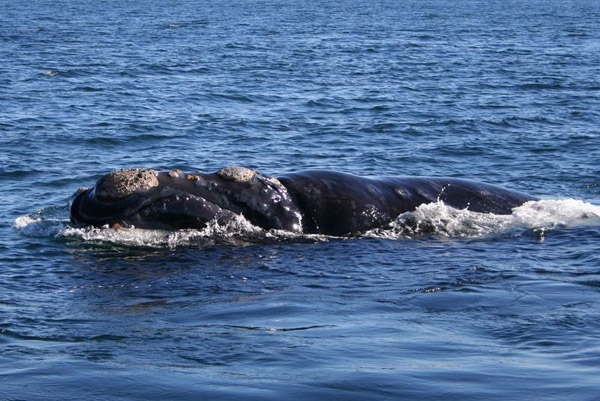 Although whales are the biggest animals on the planet, scientists have found in difficult to count them. But a new study in PLOS ONE may change this: researchers tested the idea of counting whales using high resolution satellite imagery. Employing a single image from the WorldView2 satellite, scientists went about counting a pod of southern […]
Although whales are the biggest animals on the planet, scientists have found in difficult to count them. But a new study in PLOS ONE may change this: researchers tested the idea of counting whales using high resolution satellite imagery. Employing a single image from the WorldView2 satellite, scientists went about counting a pod of southern […]
Scientists discover new whale species
 Researchers have described a new beaked whale species. The beaked whale family, so-called for their dolphin-like beaks, are among the world’s least known mammals. This photo shows a Blainville’s beaked whale (Mesoplodon densirostris). Photo by: NOAA. Beaked whales are incredibly elusive and rare, little-known to scientists and the public alike—although some species are three times […]
Researchers have described a new beaked whale species. The beaked whale family, so-called for their dolphin-like beaks, are among the world’s least known mammals. This photo shows a Blainville’s beaked whale (Mesoplodon densirostris). Photo by: NOAA. Beaked whales are incredibly elusive and rare, little-known to scientists and the public alike—although some species are three times […]
Photos: Japanese fishermen slaughter 41 dolphins, capture 52 in ‘The Cove’
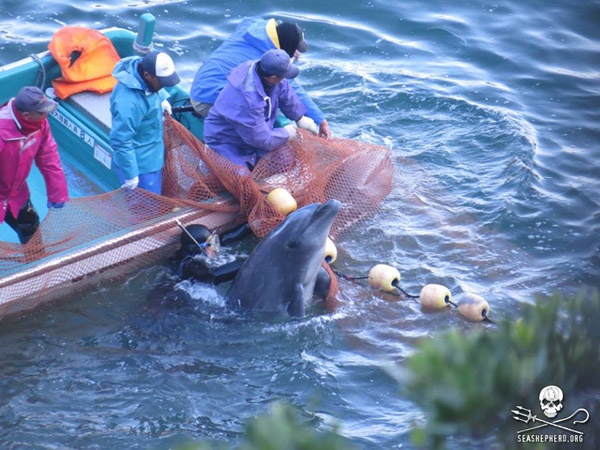 Taiji fisherman capturing a bottlenose dolphin. Photo courtesy of Sea Shepherd The annual dolphin hunt in Taiji, Japan ended on Monday with dozens being slaughtered for meat and captured for sale to amusement parks, reports Sea Shepherd, an ocean activist group that campaigns against the practice and released photos documenting the weekend’s harvest. Last week […]
Taiji fisherman capturing a bottlenose dolphin. Photo courtesy of Sea Shepherd The annual dolphin hunt in Taiji, Japan ended on Monday with dozens being slaughtered for meat and captured for sale to amusement parks, reports Sea Shepherd, an ocean activist group that campaigns against the practice and released photos documenting the weekend’s harvest. Last week […]
Japanese whale hunt stopped, for now
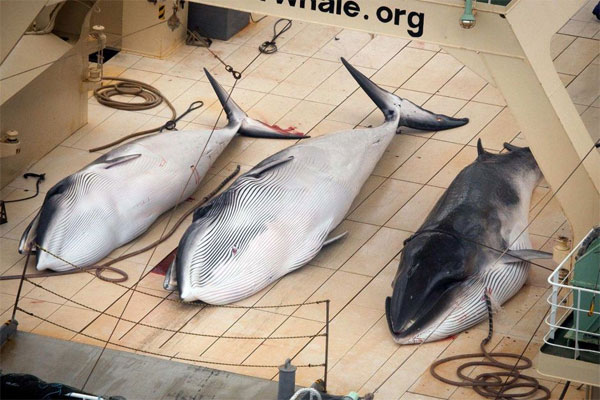 Three dead minke whales photographed by Sea Shepherd’s helicopter. Courtesy of Sea Shepherd Australia. Anti-whaling group Sea Shepherd said its fleet of ships has successfully disrupted the annual Japanese whale hunt in the waters off Antarctica. “After a 360-mile chase, The Sea Shepherd Fleet drove the Japanese whaling fleet’s factory ship, the Nisshin Maru, out […]
Three dead minke whales photographed by Sea Shepherd’s helicopter. Courtesy of Sea Shepherd Australia. Anti-whaling group Sea Shepherd said its fleet of ships has successfully disrupted the annual Japanese whale hunt in the waters off Antarctica. “After a 360-mile chase, The Sea Shepherd Fleet drove the Japanese whaling fleet’s factory ship, the Nisshin Maru, out […]
Activists urge Southwest to drop SeaWorld over whale concerns
 Orca at SeaWorld. Courtesy of Blackfish. More than 27,000 people have signed a petition calling on Southwest Airlines Co. (NYSE:LUV) to drop its partnership with SeaWorld Entertainment, Inc. (NYSE:SEAS), over the theme park’s treatment of its marine mammals, reports Change.org, the site that is hosting the petition. The petition urges Southwest to end its marketing […]
Orca at SeaWorld. Courtesy of Blackfish. More than 27,000 people have signed a petition calling on Southwest Airlines Co. (NYSE:LUV) to drop its partnership with SeaWorld Entertainment, Inc. (NYSE:SEAS), over the theme park’s treatment of its marine mammals, reports Change.org, the site that is hosting the petition. The petition urges Southwest to end its marketing […]
DNA tests reveal new dolphin species (photos)
.600.jpg) With the help of DNA tests, scientists have declared a new dolphin species that dwells off the coast of northern Australia. The discovery was made after a team of researchers looked at the world’s humpback dolphins (in the genus Sousa), which sport telltale humps just behind their dorsal fins. While long-known to science, the new, […]
With the help of DNA tests, scientists have declared a new dolphin species that dwells off the coast of northern Australia. The discovery was made after a team of researchers looked at the world’s humpback dolphins (in the genus Sousa), which sport telltale humps just behind their dorsal fins. While long-known to science, the new, […]
Fishermen illegally killing dolphins for shark-bait in Peru (video)
 Peruvian fishermen slaughtered dolphins to use as bait for shark fishing, an undercover investigation has revealed. Footage showed infant and adult dolphins being harpooned then stabbed and clubbed before, in some cases, being cut open and butchered while still alive. The slaughtered dolphins were cut up and used as bait. Dolphins are also killed for […]
Peruvian fishermen slaughtered dolphins to use as bait for shark fishing, an undercover investigation has revealed. Footage showed infant and adult dolphins being harpooned then stabbed and clubbed before, in some cases, being cut open and butchered while still alive. The slaughtered dolphins were cut up and used as bait. Dolphins are also killed for […]
Sonar used by oil company caused mass whale stranding in Madagascar
 An oil company’s use of a high-frequency mapping sonar system was responsible for a mass whale stranding in northwest Madagascar in 2008, finds a new report. The report, issued today by an independent scientific review panel, found that the stranding of roughly 100 melon-headed whales was “primarily triggered” by seismic testing conducted by an ExxonMobil […]
An oil company’s use of a high-frequency mapping sonar system was responsible for a mass whale stranding in northwest Madagascar in 2008, finds a new report. The report, issued today by an independent scientific review panel, found that the stranding of roughly 100 melon-headed whales was “primarily triggered” by seismic testing conducted by an ExxonMobil […]
Are seagulls killing whales in Patagonia?
 It sounds ludicrous, but it could just be true: scientists say seagulls may be responsible for hundreds of southern right whale mortalities off the Argentine coastline. Since 2003, scientists have documented the deaths of 605 southern right whales (Eubalaena australis) near Península Valdés which the whales use as a nursery. Notably, 88 percent of these […]
It sounds ludicrous, but it could just be true: scientists say seagulls may be responsible for hundreds of southern right whale mortalities off the Argentine coastline. Since 2003, scientists have documented the deaths of 605 southern right whales (Eubalaena australis) near Península Valdés which the whales use as a nursery. Notably, 88 percent of these […]
Munching on marine plastic kills sperm whale
 Inside Moby-Dick’s stomach, there’s a lot more than Ahab’s leg. What do children’s toys, balloons, mattresses and plastic bags have in common? They can, along with more non-biodegradable pollutants, be found in the belly of a sperm whale, the topic of a new study in the Marine Pollution Bulletin. The same whale that swallowed Jonah […]
Inside Moby-Dick’s stomach, there’s a lot more than Ahab’s leg. What do children’s toys, balloons, mattresses and plastic bags have in common? They can, along with more non-biodegradable pollutants, be found in the belly of a sperm whale, the topic of a new study in the Marine Pollution Bulletin. The same whale that swallowed Jonah […]
Japan killed record low number of whales
 Japan blamed environmental activists for a “record low” take during this year’s whaling season in the Southern Ocean, reports Kyodo News. Agriculture, Forestry and Fisheries Minister Yoshimasa Hayashi said the recent hunt yielded only 103 Antarctic minke whales and no fin whales, according to the agency’s web site. The target had been 1,000 whales for […]
Japan blamed environmental activists for a “record low” take during this year’s whaling season in the Southern Ocean, reports Kyodo News. Agriculture, Forestry and Fisheries Minister Yoshimasa Hayashi said the recent hunt yielded only 103 Antarctic minke whales and no fin whales, according to the agency’s web site. The target had been 1,000 whales for […]
Photo: Pod of 100,000 dolphins spotted off California coast
 Photo of the ‘super mega-pod’ by Antonio Ramirez, a passenger aboard the Hornblower Cruise that spotted the dolphins last Thursday. A ‘super mega-pod’ of some 100,000 dolphins was spotted off the coast of San Diego last week, according to a report from NBC San Diego. The giant pod of common dolphins (Delphinus delphis) was sighted […]
Photo of the ‘super mega-pod’ by Antonio Ramirez, a passenger aboard the Hornblower Cruise that spotted the dolphins last Thursday. A ‘super mega-pod’ of some 100,000 dolphins was spotted off the coast of San Diego last week, according to a report from NBC San Diego. The giant pod of common dolphins (Delphinus delphis) was sighted […]
Save Lolita: new film urges release of captive killer whale
 The 3rd Annual New York Wildlife Conservation Film Festival (WFCC.org) runs from January 30 – February 2, 2013. Ahead of the event, Mongabay.com is running a series of Q&As with filmmakers and presenters. For more interviews, please see our WCFF feed. Through his new 90-second PSA, Save Lolita, filmmaker Daniel Azarian wanted to connect people […]
The 3rd Annual New York Wildlife Conservation Film Festival (WFCC.org) runs from January 30 – February 2, 2013. Ahead of the event, Mongabay.com is running a series of Q&As with filmmakers and presenters. For more interviews, please see our WCFF feed. Through his new 90-second PSA, Save Lolita, filmmaker Daniel Azarian wanted to connect people […]
Whale only known from bones washes up on beach in New Zealand
- In 2010, a whale mother and male calf were found dead on Opape Beach in New Zealand. Although clearly in the beaked whale family scientists thought the pair were relatively well-known Gray’s beaked whales.
- That is until DNA findings told a shocking story: the mother and calf were actually spade-toothed beaked whales, a species no one had ever seen before as anything more than a pile of bones.
Maui’s dolphins still in danger of extinction despite New Zealand’s protective measures
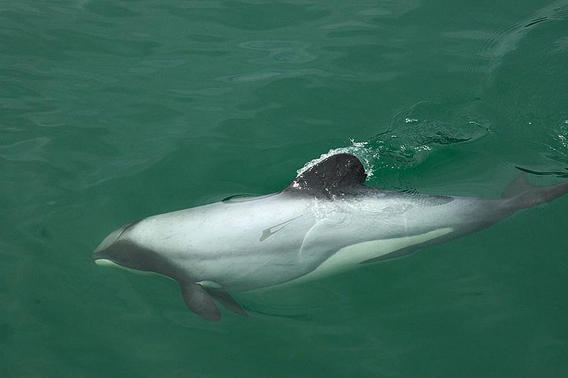 Hector’s dolphin, the parent species of the Maui’s dolphin. Photo by: James Shook. The New Zealand government’s recent efforts to protect the world’s smallest dolphin have come under scrutiny from various conservation organizations at the 64th meeting of the International Whaling Commission (IWC). There are only 55 Maui dolphins (Cephalorhynchus hectori maui) now found on […]
Hector’s dolphin, the parent species of the Maui’s dolphin. Photo by: James Shook. The New Zealand government’s recent efforts to protect the world’s smallest dolphin have come under scrutiny from various conservation organizations at the 64th meeting of the International Whaling Commission (IWC). There are only 55 Maui dolphins (Cephalorhynchus hectori maui) now found on […]
Humpback whales delaying migration due to Antarctic changes
 Humpback whale. Photo by Rhett A. Butler Humpback whales in the Antarctic are delaying their migration to feed on krill that are staying later due to reduced extent of sea ice, a possible consequence of climate change, reports a study published in the journal Endangered Species Research [PDF. The research, which was led by David […]
Humpback whale. Photo by Rhett A. Butler Humpback whales in the Antarctic are delaying their migration to feed on krill that are staying later due to reduced extent of sea ice, a possible consequence of climate change, reports a study published in the journal Endangered Species Research [PDF. The research, which was led by David […]
Deepwater Horizon oil spill may have played role in dolphin deaths
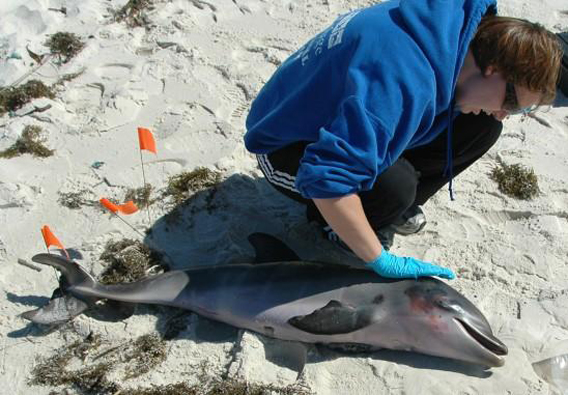 Researcher with dead dolphin calf. Photo courtesy of the University of Central Florida. In the first four months of 2011, 186 bottlenose dolphins (Tursiops truncatus) were found dead in the Gulf of Mexico, nearly half of them dolphin calves many of whom were perinatal, or near birth. Researchers now believe a number of factors may […]
Researcher with dead dolphin calf. Photo courtesy of the University of Central Florida. In the first four months of 2011, 186 bottlenose dolphins (Tursiops truncatus) were found dead in the Gulf of Mexico, nearly half of them dolphin calves many of whom were perinatal, or near birth. Researchers now believe a number of factors may […]
Over 30 Yangtze porpoises found dead in China as population nears extinction
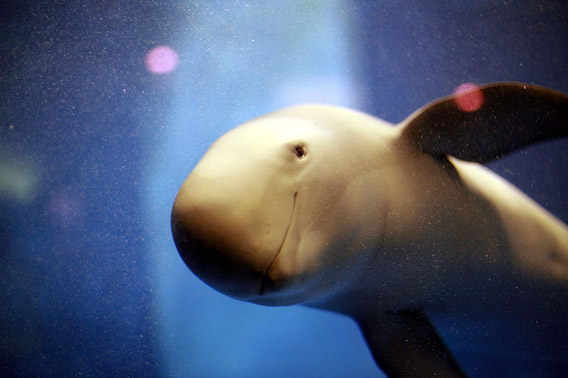 There are two subspecies of the finless porpoise, one is found in the Yangtze River, the other in Japan, Taiwan, and South Korea. This individual is the latter and was photographed in a Japanese aquarium. Photo by: Kenichi Nobusue. Six years after the Yangtze river dolphin (Lipotes vexillifer), or baiji, was declared “functionally extinct” by […]
There are two subspecies of the finless porpoise, one is found in the Yangtze River, the other in Japan, Taiwan, and South Korea. This individual is the latter and was photographed in a Japanese aquarium. Photo by: Kenichi Nobusue. Six years after the Yangtze river dolphin (Lipotes vexillifer), or baiji, was declared “functionally extinct” by […]
Video: All white killer whale spotted in Russia
Scientists in Russia have captured the first-known video footage of an all-white killer whale. The male orca, dubbed “Iceberg”, was sighted during a research trip off Kamchatka. Iceberg seems to be treated normally by other whales in its pod, according to Erich Hoyt, an orca scientist who was co-leading the trip when the sighting was […]
Beyond Bigfoot: the science of cryptozoology
- Anyone who doubts cryptozoology, which in Greek means the “study of hidden animals,” should remember the many lessons of the past 110 years:
- the mountain gorilla (discovered in 1902), the colossal squid (discovered in 1925, but a full specimen not caught until 1981), and the saola (discovered in 1992) to name a few.
- Every year, almost 20,000 new species are described by the world’s scientists, and a new book by Dr. Karl Shuker highlights some of the most incredible and notable new animals uncovered during the past century.
World’s smallest dolphin: only 55 left, but continue to drown in nets
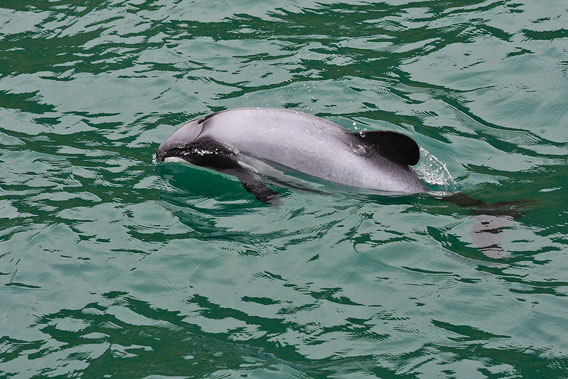 Hector’s dolphin is the parent species of the subspecies Maui’s dolphin. Both are only found in New Zealand. Photo by: Bigstock. The world’s smallest dolphin is also the closest to extinction. New Zealand government figures show that Maui’s dolphin (Cephalorhynchus hectori maui) are down to just 55 mature individuals, falling from 111 in 2005. The […]
Hector’s dolphin is the parent species of the subspecies Maui’s dolphin. Both are only found in New Zealand. Photo by: Bigstock. The world’s smallest dolphin is also the closest to extinction. New Zealand government figures show that Maui’s dolphin (Cephalorhynchus hectori maui) are down to just 55 mature individuals, falling from 111 in 2005. The […]
Featured video: scientists capture first footage of Shepherd’s beaked whale
Scientists have captured what is believed to be the world’s first footage of the cryptic Shepherd’s beaked whale (Tasmacetus shepherdi), one of a number of beaked whale species about which scientists know almost nothing. The footage was taken in Bass Strait, lying between Australia and Tasmania. There have only been a few confirmed sightings of […]
Amazon.com stops selling whale meat
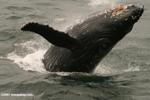 Amazon Japan, a subsidiary of Amazon.com, pulled all whale meat products (and possibly dolphin meat) from its site after a new report by the Environmental Investigation Agency (EIA) and the Humane Society International highlighted the issue. Last December the organizations recorded 147 whale products on sale at Amazon Japan despite an international whaling moratorium since […]
Amazon Japan, a subsidiary of Amazon.com, pulled all whale meat products (and possibly dolphin meat) from its site after a new report by the Environmental Investigation Agency (EIA) and the Humane Society International highlighted the issue. Last December the organizations recorded 147 whale products on sale at Amazon Japan despite an international whaling moratorium since […]
New sanctuaries declared for Asia’s freshwater dolphins
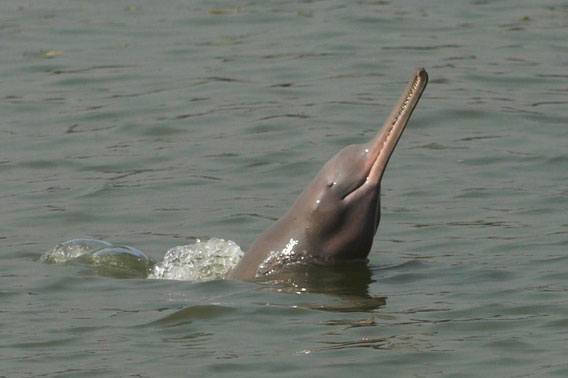 Ganges River dolphin in the Sundarbans. Photo by: Rubaiyat Mansur. Bangladesh has declared three new sanctuaries to help protect the south Asian river dolphin (Platanista gangetica) in the Sundarbans, the world’s largest mangrove forest. Split into two subspecies, the Ganges River dolphin (Platanista gangetica gangetica) and the Irrawaddy River dolphin (Platanista gangetica minor), the new […]
Ganges River dolphin in the Sundarbans. Photo by: Rubaiyat Mansur. Bangladesh has declared three new sanctuaries to help protect the south Asian river dolphin (Platanista gangetica) in the Sundarbans, the world’s largest mangrove forest. Split into two subspecies, the Ganges River dolphin (Platanista gangetica gangetica) and the Irrawaddy River dolphin (Platanista gangetica minor), the new […]
87 marine mammals still eaten by people
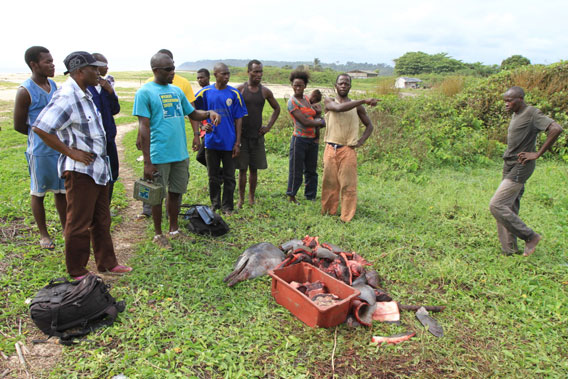 Local fishers in Brazzaville in the Republic of Congo with a butchered Atlantic humpback dolphin, a West African endemic that has been extirpated from much of its range as fisheries decline and people shift to other sources of protein. Photo by: Tim Collins. Threats to marine mammals usually include climate change, drowning as by-catch, pollution, […]
Local fishers in Brazzaville in the Republic of Congo with a butchered Atlantic humpback dolphin, a West African endemic that has been extirpated from much of its range as fisheries decline and people shift to other sources of protein. Photo by: Tim Collins. Threats to marine mammals usually include climate change, drowning as by-catch, pollution, […]
Featured video: tuna industry bycatch includes sea turtles, dolphins, whales
WARNING: video is graphic. A Greenpeace video, using footage from a whistleblower, shows disturbing images of the tuna industry operating in the unregulated waters of the Pacific Ocean. Using fish aggregation devices (FADs) and purse seine nets, the industry is not only able to catch entire schools of tuna, including juvenile, but whatever else is […]
How much is the life of a whale worth?
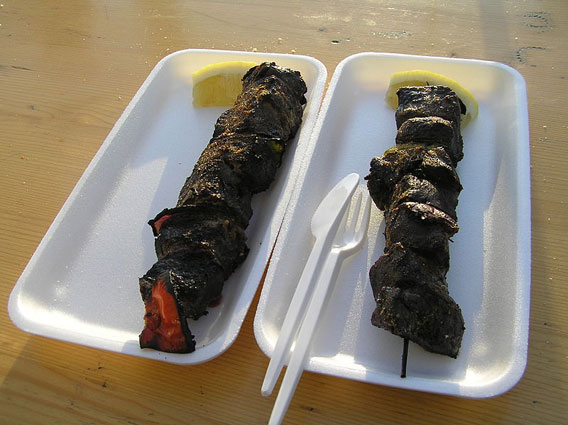 Minke whale kabob served up at the Sea Baron restaurant in Reykjavik Harbour area, Iceland. Photo by:Thjurexoell. How do you end a decades-long conflict between culture and conservation? How do you stop a conflict where both sides are dug in? A new paper in Nature proposes a way to end the long and bitter battle […]
Minke whale kabob served up at the Sea Baron restaurant in Reykjavik Harbour area, Iceland. Photo by:Thjurexoell. How do you end a decades-long conflict between culture and conservation? How do you stop a conflict where both sides are dug in? A new paper in Nature proposes a way to end the long and bitter battle […]
Penurunan predator puncak dan megafauna ‘pengaruh manusia yang paling mudah menyebar pada alam ‘
 Singa betina mempertahankan wildebeest yang terbunuh di Tanzania. Foto oleh: Rhett A. Butler. Populasi serigala di seluruh dunia telah turun sekitar 99 persen dari jumlah populasi yang pernah ada dalam sejarah. Populasi singa jatuh dari 450.000 menjadi 20.000 dalam 50 tahun. Tiga subspesies harimau punah di abad ke-20. Penangkapan ikan yang berlebihan dan pemotongan sirip […]
Singa betina mempertahankan wildebeest yang terbunuh di Tanzania. Foto oleh: Rhett A. Butler. Populasi serigala di seluruh dunia telah turun sekitar 99 persen dari jumlah populasi yang pernah ada dalam sejarah. Populasi singa jatuh dari 450.000 menjadi 20.000 dalam 50 tahun. Tiga subspesies harimau punah di abad ke-20. Penangkapan ikan yang berlebihan dan pemotongan sirip […]
New species of bottlenose discovered in Australia (PHOTO)
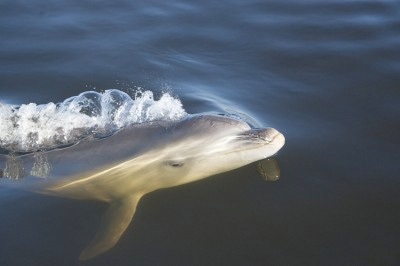 Researchers have discovered a new species of dolphin in Australia, reports ABC News. Analysis of bottlenose dolphins in Port Philip and the Gippsland Lakes in Southeastern Australia revealed them to be declared a new species. “This is an incredibly fascinating discovery as there have only been three new dolphin species formally described and recognised since […]
Researchers have discovered a new species of dolphin in Australia, reports ABC News. Analysis of bottlenose dolphins in Port Philip and the Gippsland Lakes in Southeastern Australia revealed them to be declared a new species. “This is an incredibly fascinating discovery as there have only been three new dolphin species formally described and recognised since […]
Decline in top predators and megafauna ‘humankind’s most pervasive influence on nature’
 Lioness defends wildebeest kill in Tanzania. Photo by: Rhett A. Butler. Worldwide wolf populations have dropped around 99 percent from historic populations. Lion populations have fallen from 450,000 to 20,000 in 50 years. Three subspecies of tiger went extinct in the 20th Century. Overfishing and finning has cut some shark populations down by 90 percent […]
Lioness defends wildebeest kill in Tanzania. Photo by: Rhett A. Butler. Worldwide wolf populations have dropped around 99 percent from historic populations. Lion populations have fallen from 450,000 to 20,000 in 50 years. Three subspecies of tiger went extinct in the 20th Century. Overfishing and finning has cut some shark populations down by 90 percent […]
India plans to aid dwindling Ganges River dolphin
 The Indian government has announced that it plans to develop a program to raise the population of its native Ganges river dolphin (Platanista gangetica gagnetica), a subspecies of the South Asian river dolphin. During a question and answer session Jairam Ramesh, India’s Environment and Forests Minister, said that the dolphin’s current population was estimated at […]
The Indian government has announced that it plans to develop a program to raise the population of its native Ganges river dolphin (Platanista gangetica gagnetica), a subspecies of the South Asian river dolphin. During a question and answer session Jairam Ramesh, India’s Environment and Forests Minister, said that the dolphin’s current population was estimated at […]
Kite-photography gives new perspective to whale migration
 A new project sponsored by Nokia uses KAPing – kite aerial photography – to get an innovative look at whale behavior. The project will be taking place in Hawaii and will document the area’s annual humpback whale migration. KAPing uses kites to suspend cameras, providing a birds-eye view of a scene without need for a […]
A new project sponsored by Nokia uses KAPing – kite aerial photography – to get an innovative look at whale behavior. The project will be taking place in Hawaii and will document the area’s annual humpback whale migration. KAPing uses kites to suspend cameras, providing a birds-eye view of a scene without need for a […]
Japanese making themselves sick with dolphin hunt
 Japan’s dolphin hunt of Dall’s porpoise (Phocoenoides dalli) could be making people sick, according to a new study by the Environmental Investigation Agency (EIA) and Campaign Whale. The controversial hunt, which kills some 15,000 dolphins annually, produces cheap meat-for-consumption that on average contains over double Japan’s limit on mercury contamination. “We are very concerned that […]
Japan’s dolphin hunt of Dall’s porpoise (Phocoenoides dalli) could be making people sick, according to a new study by the Environmental Investigation Agency (EIA) and Campaign Whale. The controversial hunt, which kills some 15,000 dolphins annually, produces cheap meat-for-consumption that on average contains over double Japan’s limit on mercury contamination. “We are very concerned that […]
Island nation announces Ukraine-sized sanctuary for whales and dolphins
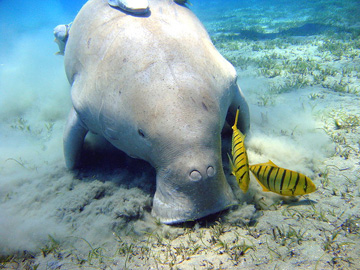 Dolphins, whales, and dugongs will be safe from hunting in the waters surrounding the Pacific nation of Palau. At the Convention on Biological Diversity (CBD) in Nagoya, Japan, Palau’s Minister of the Environment, Natural Resources and Tourism, Harry Fritz, announced the establishment of a marine mammal sanctuary covering over 230,000 square miles (600,000 square kilometers) […]
Dolphins, whales, and dugongs will be safe from hunting in the waters surrounding the Pacific nation of Palau. At the Convention on Biological Diversity (CBD) in Nagoya, Japan, Palau’s Minister of the Environment, Natural Resources and Tourism, Harry Fritz, announced the establishment of a marine mammal sanctuary covering over 230,000 square miles (600,000 square kilometers) […]
Flickr reveals longest whale migration
 Communal photo sharing site, Flickr, has allowed researchers to discover the longest migration by a whale yet recorded. Ten years ago a female humpback whale swam from Brazil to Madagascar, covering around 6,090 miles (9,800 kilometers). The migration tops the previous record by 2,485 miles (4,000 kilometers). Not only is this a record for a […]
Communal photo sharing site, Flickr, has allowed researchers to discover the longest migration by a whale yet recorded. Ten years ago a female humpback whale swam from Brazil to Madagascar, covering around 6,090 miles (9,800 kilometers). The migration tops the previous record by 2,485 miles (4,000 kilometers). Not only is this a record for a […]
Conservation photography: on shooting and saving the world’s largest temperate rainforest, an interview with Amy Gulick
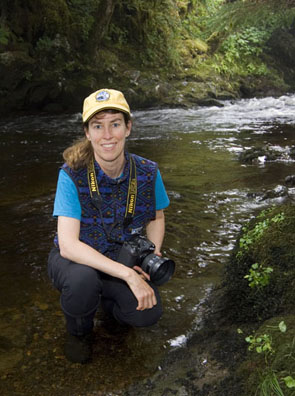 Most of the US’s large ecosystems are but shadows of their former selves. The old-growth deciduous forests that once covered nearly all of the east and mid-west continental US are gone, reduced to a few fragmented patches that are still being lost. The tall grassy plains that once stretched further than any eye could see […]
Most of the US’s large ecosystems are but shadows of their former selves. The old-growth deciduous forests that once covered nearly all of the east and mid-west continental US are gone, reduced to a few fragmented patches that are still being lost. The tall grassy plains that once stretched further than any eye could see […]
Extinct animals are quickly forgotten: the baiji and shifting baselines
- In 2006 a survey in China to locate the endangered Yangtze River dolphin, known as the baiji, found no evidence of its survival.
- Despondent, researchers declared that the baiji was likely extinct.
- Four years later and the large charismatic aquatic mammal is not only ‘likely extinct’, but in danger of being forgotten, according to a surprising new study ‘Rapidly Shifting Baselines in Yangtze Fishing Communities and Local Memory of Extinct Species’ in Conservation Biology.
Photos: ten beloved species threatened by global warming
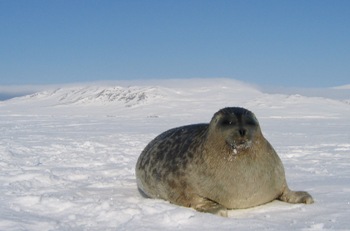 The International Union for the Conservation of Nature (IUCN) has released a list of ten species that are likely to be among the hardest hit by climate change, including beloved species such as the leatherback sea turtle, the koala, the emperor penguin, the clownfish, and the beluga whale. The timing of the list coincides with […]
The International Union for the Conservation of Nature (IUCN) has released a list of ten species that are likely to be among the hardest hit by climate change, including beloved species such as the leatherback sea turtle, the koala, the emperor penguin, the clownfish, and the beluga whale. The timing of the list coincides with […]
The Yangtze River may have lost another inhabitant: the Chinese paddlefish
- In December of 2006 it was announced that the Yangtze River dolphin, commonly known as the baiji, had succumbed to extinction.
- The dolphin had survived on earth for 20 million years, but the species couldn’t survive the combined onslaught of pollution, habitat loss, boat traffic, entanglement in fishing hooks, death from illegal electric fishing, and the construction of several massive dams.
- Now, another flagship species of the Yangtze River appears to have vanished.
Whale skeleton reveals species unknown to science
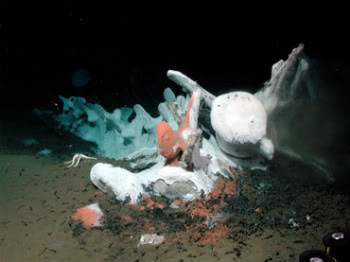 The importance of a whale to the oceanic ecosystem does not end with its life. After dying, a whale’s body sinks to the bottom of the ocean and becomes food for many species, some of whom specialize on feeding on these corpses. Using underwater cameras, researchers with the University of Gothenburg, Sweden have discovered nine […]
The importance of a whale to the oceanic ecosystem does not end with its life. After dying, a whale’s body sinks to the bottom of the ocean and becomes food for many species, some of whom specialize on feeding on these corpses. Using underwater cameras, researchers with the University of Gothenburg, Sweden have discovered nine […]
Slaughter of dolphins and whales begins in cove made famous by film
Japan Probe reports that the annual dolphin slaughter by fishermen in the Japanese town of Taiji has begun. The hunt was delayed by the presence of Japanese and foreign press in the cove during the first days when the hunt was supposed to begin. Japan Probe states that thirteen boats left the harbor at 5:30 […]
Ganges River Dolphin population falls below 300, faces new threat from oil exploration
 The Ganges River Dolphin faces a high risk of extinction in India’s Brahmaputra river system unless critical habitat is protected, report conservationists. Once abundant in the Ganges and Brahmaputra river systems in India and Bangladesh, the population of the Ganges River Dolphins has fallen sharply over the past century due to accidental bycatch by fishermen, […]
The Ganges River Dolphin faces a high risk of extinction in India’s Brahmaputra river system unless critical habitat is protected, report conservationists. Once abundant in the Ganges and Brahmaputra river systems in India and Bangladesh, the population of the Ganges River Dolphins has fallen sharply over the past century due to accidental bycatch by fishermen, […]
Iceland reaffirms whaling targets for 2009
Iceland raises whale killing quota to 150 fin whales, 100 minkes per year
A new reason to ban whaling: your health
A new reason to ban whaling: your health A new reason to ban whaling: your health mongabay.com November 28, 2008
Supreme Court lifts ban on sonar testing, whales lose
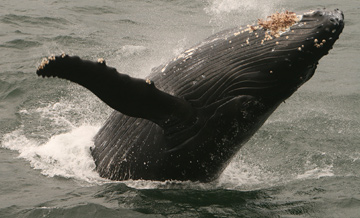 Supreme Court lifts ban on sonar testing, whales lose Supreme Court lifts ban on sonar testing, whales lose mongabay.com November 12, 2008 Bad news for whales as the Supreme Court rules military exercises can resume off the coast of California. Court doesn’t weigh in on the ecological impacts of testing, but the process lower courts […]
Supreme Court lifts ban on sonar testing, whales lose Supreme Court lifts ban on sonar testing, whales lose mongabay.com November 12, 2008 Bad news for whales as the Supreme Court rules military exercises can resume off the coast of California. Court doesn’t weigh in on the ecological impacts of testing, but the process lower courts […]
U.S., Mexico, Canada pledge to save the vaquita from extinction
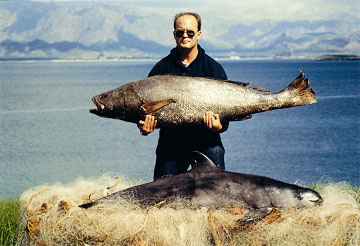 U.S., Mexico, Canada pledge to save the vaquita from extinction U.S., Mexico, Canada pledge to save the vaquita from extinction mongabay.com October 30, 2008 Last stand for the world’s smallest and rarest porpoise
U.S., Mexico, Canada pledge to save the vaquita from extinction U.S., Mexico, Canada pledge to save the vaquita from extinction mongabay.com October 30, 2008 Last stand for the world’s smallest and rarest porpoise
Argentina bans fishing, trawling in eco-rich area
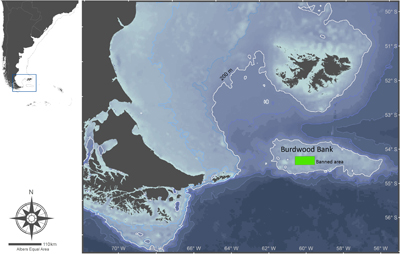 Argentina bans fishing, trawling in eco-rich area Argentina bans fishing, trawling in eco-rich area mongabay.com October 9, 2008
Argentina bans fishing, trawling in eco-rich area Argentina bans fishing, trawling in eco-rich area mongabay.com October 9, 2008
Whaling Commission issues media blackout on discussions to lift whale killing ban
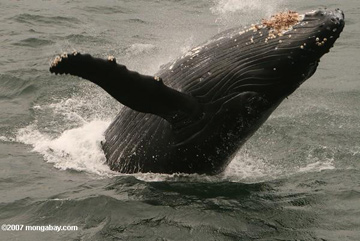 IWC issues media blackout on discussions to lift whaling ban IWC issues media blackout on discussions to lift whaling ban Jeremey Hance, mongabay.com September 11, 2008 The fate of the ban on whale hunting to be decided behind closed doors The survival of whales is perhaps the most successful conservation story of the 20th century. […]
IWC issues media blackout on discussions to lift whaling ban IWC issues media blackout on discussions to lift whaling ban Jeremey Hance, mongabay.com September 11, 2008 The fate of the ban on whale hunting to be decided behind closed doors The survival of whales is perhaps the most successful conservation story of the 20th century. […]
Whale meat is back on the menu in Iceland
Whale meat is back on the menu in Iceland Whale meat is back on the menu in Iceland mongabay.com September 2, 2008 Whale meat is back at restaurants and food markets in Iceland, reports the WALL STREET JOURNAL. Gunnar Bergmann Jonsson, a marketer for Iceland’s only licensed whaling company, Hrefnuveidimenn ehf, is working to repackage […]
The extinction of the baiji a ‘wake-up call’ to conserve vaquita and other cetaceans
 The extinction of the baiji a ‘wake-up call’ to conserve vaquita and other cetaceans An interview with Dr. Jay Barlow: Extinction of the baiji a ‘wake-up call’ to conserve vaquita and other cetaceans Jeremy Hance, mongabay.com August 25, 2008 In December of 2006 an expedition spent six weeks surveying the Yangtze River in China for […]
The extinction of the baiji a ‘wake-up call’ to conserve vaquita and other cetaceans An interview with Dr. Jay Barlow: Extinction of the baiji a ‘wake-up call’ to conserve vaquita and other cetaceans Jeremy Hance, mongabay.com August 25, 2008 In December of 2006 an expedition spent six weeks surveying the Yangtze River in China for […]
The long-ignored ocean emergency and what can be done to address it
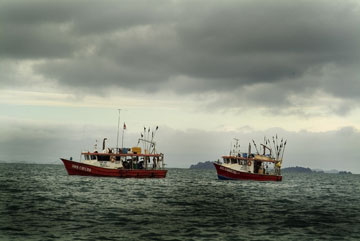 This year has been full of bad news regarding marine ecosystems: one-third of coral species threatened with extinction, dead-zones spread to 415 sites, half of U.S. reefs in fair or bad condition, increase in ocean acidification, tuna and shark populations collapsing, and only four percent of ocean considered pristine. Jeremy Jackson, director of the Scripps […]
This year has been full of bad news regarding marine ecosystems: one-third of coral species threatened with extinction, dead-zones spread to 415 sites, half of U.S. reefs in fair or bad condition, increase in ocean acidification, tuna and shark populations collapsing, and only four percent of ocean considered pristine. Jeremy Jackson, director of the Scripps […]
Whale biomimicry inspires better wind turbines
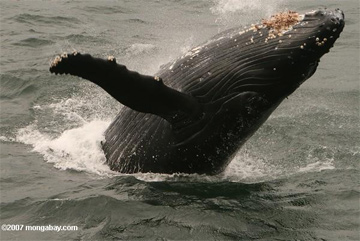 Whale biomimicry inspires better wind turbines Whale biomimicry inspires better wind turbines mongabay.com July 7, 2008 By studying and mimicking the characteristics of the flippers, fins and tails of whales and dolphins, engineers have devised more a efficient way to generate wind power, reports a researcher presenting at the Society for Experimental Biology’s Annual Meeting […]
Whale biomimicry inspires better wind turbines Whale biomimicry inspires better wind turbines mongabay.com July 7, 2008 By studying and mimicking the characteristics of the flippers, fins and tails of whales and dolphins, engineers have devised more a efficient way to generate wind power, reports a researcher presenting at the Society for Experimental Biology’s Annual Meeting […]
Humpback whale population is recovering
Humpback whale population is recovering Humpback whale population is recovering mongabay.com May 21, 2008 The number of humpback whales in the North Pacific Ocean has increased substantially since international and federal protections were put into place in the 1960s and 70s, according to a new study involving more than 400 whale researchers throughout the Pacific […]
New species of river dolphin discovered in the Amazon
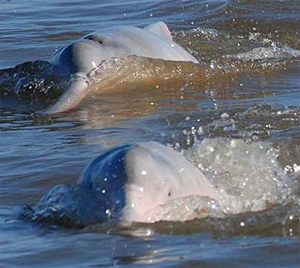 New species of river dolphin discovered in the Amazon New species of river dolphin discovered in the Amazon mongabay.com April 30, 2008 Researchers have identified a new species of river dolphin in the Bolivian Amazon according to the Whale and Dolphin Conservation Society (WDCS). The announcement was made at a conservation workshop in Santa Cruz […]
New species of river dolphin discovered in the Amazon New species of river dolphin discovered in the Amazon mongabay.com April 30, 2008 Researchers have identified a new species of river dolphin in the Bolivian Amazon according to the Whale and Dolphin Conservation Society (WDCS). The announcement was made at a conservation workshop in Santa Cruz […]
The Arctic’s most threatened marine mammals due to climate change
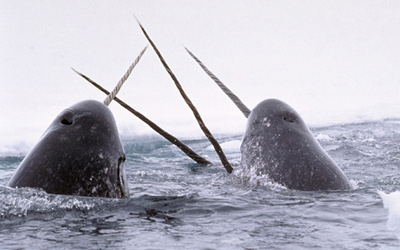 The Arctic’s most threatened marine mammals due to climate change The Arctic’s most threatened marine mammals due to climate change Jeremy Hance, mongabay.com April 25, 2008 A recent study has measured the sensitivity to Arctic marine mammals to climate change. The study found that the three species most vulnerable to climate change are the hooded […]
The Arctic’s most threatened marine mammals due to climate change The Arctic’s most threatened marine mammals due to climate change Jeremy Hance, mongabay.com April 25, 2008 A recent study has measured the sensitivity to Arctic marine mammals to climate change. The study found that the three species most vulnerable to climate change are the hooded […]
New expedition seeks evidence for survival of the ‘extinct’ Baiji
New expedition seeks evidence for survival of the ‘extinct’ Baiji New expedition seeks evidence for survival of the ‘extinct’ Baiji Jeremy Hance, mongabay.com April 16, 2008 The EDGE program, apart of the London Zoological Society, has sent an expedition to the Yangtze River to survey local fishermen for any evidence that the Baiji may still […]
Japan cancels plan to kill 50 humpback whales
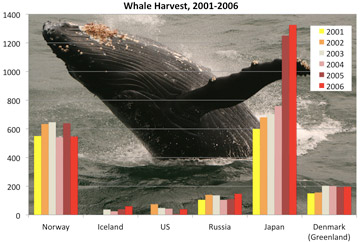 Japan cancels plan to kill 50 humpback whales Japan cancels plan to kill 50 humpback whales mongabay.com December 21, 2007 Japan has canceled highly controversial plans to kill 50 humpback whales for purported “scietific purposes” (the meat is sold in fish markets) after widespread condemnation from environmentalists and governments. The decision comes shortly following Australia’s […]
Japan cancels plan to kill 50 humpback whales Japan cancels plan to kill 50 humpback whales mongabay.com December 21, 2007 Japan has canceled highly controversial plans to kill 50 humpback whales for purported “scietific purposes” (the meat is sold in fish markets) after widespread condemnation from environmentalists and governments. The decision comes shortly following Australia’s […]
Evolution of whales challenged
 Evolution of whales challenged Origin of whales challenged mongabay.com December 19, 2007 Modern whales appear to have evolved from a raccoon-sized creature with the body of a small deer, according to scientists writing in the journal Nature. The results challenge the theory that cetaceans are descended from even-toed ungulates (artiodactyls) like hippos, as previous molecular […]
Evolution of whales challenged Origin of whales challenged mongabay.com December 19, 2007 Modern whales appear to have evolved from a raccoon-sized creature with the body of a small deer, according to scientists writing in the journal Nature. The results challenge the theory that cetaceans are descended from even-toed ungulates (artiodactyls) like hippos, as previous molecular […]
Only 150 vaquita remain
 Only 150 vaquita remain Only 150 vaquita remain mongabay.com November 19, 2007 Only 150 individual vaquita, the world’s smallest cetacean, remain, according to a new study published in Conservation Biology. The species has been decimated as accidental bycatch in fishing nets in its Gulf of California habitat. Researchers–who say there may be only a two-year […]
Only 150 vaquita remain Only 150 vaquita remain mongabay.com November 19, 2007 Only 150 individual vaquita, the world’s smallest cetacean, remain, according to a new study published in Conservation Biology. The species has been decimated as accidental bycatch in fishing nets in its Gulf of California habitat. Researchers–who say there may be only a two-year […]
Whale stranded 1,000 miles up the Amazon river
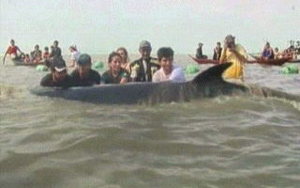 Picture: Whale stranded 1,000 miles up the Amazon river Picture: Whale stranded 1,000 miles up the Amazon river mongabay.com November 17, 2007 An 18-foot minke whale was found beached on a sandbar 1,000 miles up a tributary of the Amazon river, reported Globo television and the Associated Press. Rescuers were sent to dislodge the marine […]
Picture: Whale stranded 1,000 miles up the Amazon river Picture: Whale stranded 1,000 miles up the Amazon river mongabay.com November 17, 2007 An 18-foot minke whale was found beached on a sandbar 1,000 miles up a tributary of the Amazon river, reported Globo television and the Associated Press. Rescuers were sent to dislodge the marine […]
Apology for Whale Shooting given by Tribe
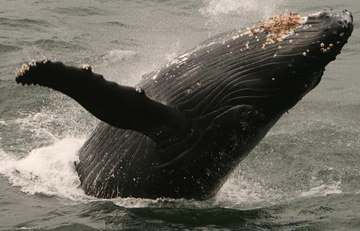 Apology for Whale Shooting given by Tribe Apology for Whale Shooting given by Tribe Joshua Hill September 13, 2007 The ninth of September saw a gray whale shot and killed by members of the Makah Tribe, off the coast of the Washington Coast, in the Strait of Juan de Fuca. From a report by the […]
Apology for Whale Shooting given by Tribe Apology for Whale Shooting given by Tribe Joshua Hill September 13, 2007 The ninth of September saw a gray whale shot and killed by members of the Makah Tribe, off the coast of the Washington Coast, in the Strait of Juan de Fuca. From a report by the […]
Gray whale populations a fraction of historic level
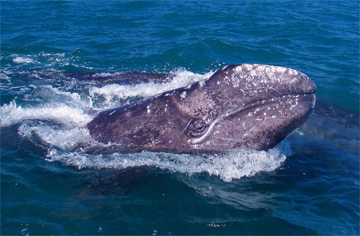 Global warming affects whale populations already reduced by historic whaling Gray whale populations only a fraction of historic level mongabay.com September 10, 2007 The current population of gray whales is one-third to one-fifth of the number found in the Pacific before industrial whaling began in the 19th century, reports a new study based on genetic […]
Global warming affects whale populations already reduced by historic whaling Gray whale populations only a fraction of historic level mongabay.com September 10, 2007 The current population of gray whales is one-third to one-fifth of the number found in the Pacific before industrial whaling began in the 19th century, reports a new study based on genetic […]
Squid chasing drove evolution of whale sonar
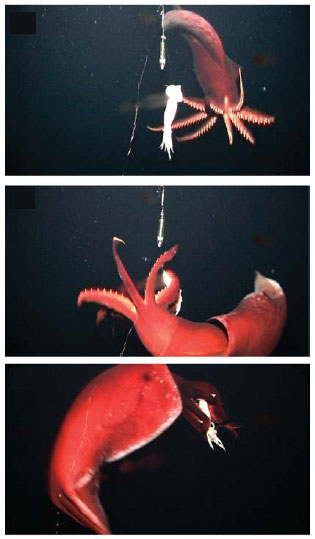 Squid chasing drove eolution of whale sonar Squid chasing drove eolution of whale sonar University of California – Berkeley September 6, 2007 A University of California at Berkeley study argues that dolphins and other toothed whales developed sonar to chase schools of squid swimming near the ocean surface at night. Behind the sailor’s lore of […]
Squid chasing drove eolution of whale sonar Squid chasing drove eolution of whale sonar University of California – Berkeley September 6, 2007 A University of California at Berkeley study argues that dolphins and other toothed whales developed sonar to chase schools of squid swimming near the ocean surface at night. Behind the sailor’s lore of […]
Rare Chinese river dolphin sighting in doubt
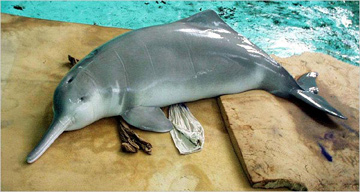 Rare Chinese river dolphin sighting in doubt Rare Chinese river dolphin sighting in question mongabay.com September 1, 2007 A prominent researcher is skeptical of last week’s reported sighting of the baiji, the Chinese river dolphin declared extinct earlier this year, according to the New York Times. The sighting near Tongling city in Anhui Province — […]
Rare Chinese river dolphin sighting in doubt Rare Chinese river dolphin sighting in question mongabay.com September 1, 2007 A prominent researcher is skeptical of last week’s reported sighting of the baiji, the Chinese river dolphin declared extinct earlier this year, according to the New York Times. The sighting near Tongling city in Anhui Province — […]
Saving beautiful – and ugly – species from extinction
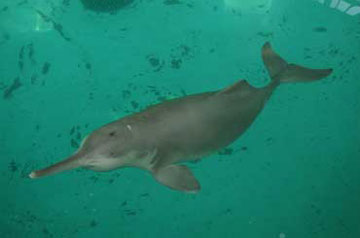 Saving beautiful – and ugly – species from extinction Saving the beautiful – and the ugly – creatures of the world Why the EDGE Matters Jeremy Hance August 30, 2007 Allow me to wax poetic about the world’s newest wildlife organization, EDGE. I must admit I’m a little in love. This singular organization was founded […]
Saving beautiful – and ugly – species from extinction Saving the beautiful – and the ugly – creatures of the world Why the EDGE Matters Jeremy Hance August 30, 2007 Allow me to wax poetic about the world’s newest wildlife organization, EDGE. I must admit I’m a little in love. This singular organization was founded […]
“Extinct” baiji river dolphin spotted alive in China
 “Extinct” baiji river dolphin spotted alive in China “Extinct” baiji river dolphin spotted alive in China mongabay.com August 29, 2007 An “extinct” baiji has been spotted alive in the Yangtze River, reports Chinese state media. The freshwater dolphin, declared extinct just days ago by a leading Chinese scientist, was seen at Xuba ferry in Tongling […]
“Extinct” baiji river dolphin spotted alive in China “Extinct” baiji river dolphin spotted alive in China mongabay.com August 29, 2007 An “extinct” baiji has been spotted alive in the Yangtze River, reports Chinese state media. The freshwater dolphin, declared extinct just days ago by a leading Chinese scientist, was seen at Xuba ferry in Tongling […]
Iceland halts whaling
 Iceland halts whaling; until demand picks up Iceland halts whaling mongabay.com August 24, 2007 With stagnant demand for whale meat nearly a year after ending its ban on commercial whaling, Iceland said it would not issue new whale-hunting quotas until it gets an export license from Japan, reports Reuters. “The whaling industry, like any other […]
Iceland halts whaling; until demand picks up Iceland halts whaling mongabay.com August 24, 2007 With stagnant demand for whale meat nearly a year after ending its ban on commercial whaling, Iceland said it would not issue new whale-hunting quotas until it gets an export license from Japan, reports Reuters. “The whaling industry, like any other […]
Extinction of the Yangtze river dolphin is confirmed
 Photos: Extinction of the Yangtze river dolphin is confirmed Photos: Extinction of the Yangtze river dolphin is confirmed mongabay.com August 8, 2007 After an extensive six-week search scientists have confirmed the probable extinction of the baiji or Yangtze river dolphin. The freshwater dolphin’s extinction had been reported late last year. “The loss of such a […]
Photos: Extinction of the Yangtze river dolphin is confirmed Photos: Extinction of the Yangtze river dolphin is confirmed mongabay.com August 8, 2007 After an extensive six-week search scientists have confirmed the probable extinction of the baiji or Yangtze river dolphin. The freshwater dolphin’s extinction had been reported late last year. “The loss of such a […]
U.S. court blocks sonar testing to protect whales
 U.S. court blocks sonar testing to protect whales U.S. court blocks sonar testing to protect whales mongabay.com August 7, 2007 A U.S. federal court blocked the Navy from using a type of sonar that environmentalists say pose a threat to whales off the coast of California. The judge noted that the Navy’s own analyses concluded […]
U.S. court blocks sonar testing to protect whales U.S. court blocks sonar testing to protect whales mongabay.com August 7, 2007 A U.S. federal court blocked the Navy from using a type of sonar that environmentalists say pose a threat to whales off the coast of California. The judge noted that the Navy’s own analyses concluded […]
How to save the world’s oceans from overfishing
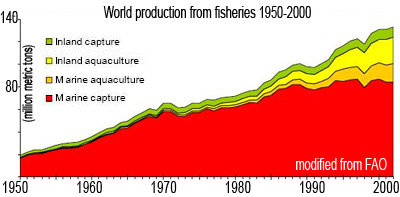 How to save the world’s oceans from overfishing How to save the world’s oceans from overfishing An interview with the Monterey Bay Aquarium’s Mike Sutton Rhett A. Butler, mongabay.com July 9, 2007 Global fishing stocks are in trouble. After expanding from 18 millions tons in 1950 to around 94 million tons in 2000, annual world […]
How to save the world’s oceans from overfishing How to save the world’s oceans from overfishing An interview with the Monterey Bay Aquarium’s Mike Sutton Rhett A. Butler, mongabay.com July 9, 2007 Global fishing stocks are in trouble. After expanding from 18 millions tons in 1950 to around 94 million tons in 2000, annual world […]
Harpoon proves whale is 115-130 years old
 A 19th-century weapon found in the neck of a 50-ton bowhead whale caught off Alaska shows that cetaceans can live more than 100 years, reports the Associated Press (AP). The 3 1/2-inch “bomb lance” fragment was found in the whale’s neck blubber and was likely manufactured in New Bedford, Massachusetts, over a century ago. The […]
A 19th-century weapon found in the neck of a 50-ton bowhead whale caught off Alaska shows that cetaceans can live more than 100 years, reports the Associated Press (AP). The 3 1/2-inch “bomb lance” fragment was found in the whale’s neck blubber and was likely manufactured in New Bedford, Massachusetts, over a century ago. The […]
South Korea fishermen cheat on whale killing
 South Korea fishermen cheat on whale killing South Korea fishermen cheat on whale killing mongabay.com May 9, 2007 Fishermen in South Korea are killing far more whales than they claim, reports an article in New Scientist Magazine. DNA fingerprinting of whale meat purchased in local markets suggests that South Korea caught 827 minke whales between […]
South Korea fishermen cheat on whale killing South Korea fishermen cheat on whale killing mongabay.com May 9, 2007 Fishermen in South Korea are killing far more whales than they claim, reports an article in New Scientist Magazine. DNA fingerprinting of whale meat purchased in local markets suggests that South Korea caught 827 minke whales between […]
Japan will kill 50 humpbacks
 Japan will kill 50 humpbacks Japan will kill 50 humpbacks Rhett A. Butler, mongabay.com April 26, 2007 Humpback whale populations are rebounding but concerns are rising over Japan’s plans to kill 50 humpback whales for “scientific” research, reports a paper published in the latest issue of Science. In the “News Focus” section of Science, Virginia […]
Japan will kill 50 humpbacks Japan will kill 50 humpbacks Rhett A. Butler, mongabay.com April 26, 2007 Humpback whale populations are rebounding but concerns are rising over Japan’s plans to kill 50 humpback whales for “scientific” research, reports a paper published in the latest issue of Science. In the “News Focus” section of Science, Virginia […]
The news of extinction: western media’s response to the demise of the Baiji
 The news came and went with an alacrity that I found alarming, almost jolting. I waited for weeks, faithfully; I could not believe that the initial announcement would be followed by nothing but silence on the issue, no rationalizations, no opinions, no discussions, no outpourings of grief. Just silence. The Goddess of the Yangtze’, the […]
The news came and went with an alacrity that I found alarming, almost jolting. I waited for weeks, faithfully; I could not believe that the initial announcement would be followed by nothing but silence on the issue, no rationalizations, no opinions, no discussions, no outpourings of grief. Just silence. The Goddess of the Yangtze’, the […]
Jumbo squid and sperm whales tagged
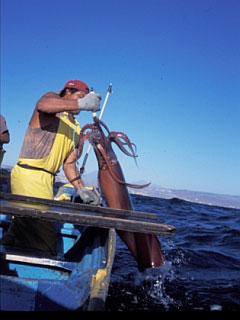 Jumbo squid and sperm whales tagged Jumbo squid and sperm whales tagged mongabay.com March 8, 2007 Scientists have simulatenously tagged sperm whales and jumbo squid off Mexico’s Pacific coast, allowing them to be tracked by satellite even as they dive to depths exceeding 3000 feet. Details of the effort are published in in the March […]
Jumbo squid and sperm whales tagged Jumbo squid and sperm whales tagged mongabay.com March 8, 2007 Scientists have simulatenously tagged sperm whales and jumbo squid off Mexico’s Pacific coast, allowing them to be tracked by satellite even as they dive to depths exceeding 3000 feet. Details of the effort are published in in the March […]
China will continue search for ‘extinct’ baiji river dolphin
 China will continue search for ‘extinct’ baiji river dolphin China will continue search for ‘extinct’ baiji river dolphin mongabay.com December 17, 2006 Chinese state media reports that scientists will continue to search for the baiji dolphin even after a 38-day search failed to produce any evidence of its existence in the Yangtze River. Xinhua quoted […]
China will continue search for ‘extinct’ baiji river dolphin China will continue search for ‘extinct’ baiji river dolphin mongabay.com December 17, 2006 Chinese state media reports that scientists will continue to search for the baiji dolphin even after a 38-day search failed to produce any evidence of its existence in the Yangtze River. Xinhua quoted […]
A farewell to the Yangtze’s ghost, the Baiji
- The Baiji, the Yangtze River dolphin, was officially declared ‘functionally extinct’ this month.
- The Baiji is survived by other river dolphins, all themselves threatened.
Goodbye to the Baiji
- After a short illness spurred by pollution, overfishing, boat traffic, and obstructions like dams, the Baiji was declared ‘functionally extinct’ last night.
- As a species, the river dolphin found only in China’s Yangtze River was 20 million years.
- The Baiji is survived by other river dolphins, all themselves threatened, in the Ganges, Indus, Amazon, Orinoco, and La Plata rivers. No memorial service will be held.
The Vaquita, the world’s smallest cetacean, dives toward extinction
 The Vaquita, the world’s smallest cetacean, dives toward extinction The Vaquita, the world’s smallest cetacean, dives toward extinction The culprit of the littlest porpoise’s fate: accidental mortality as “bycatch” Rhett Butler, mongabay.com December 10, 2006 Accidental death in fishing nets is driving the world’s smallest cetacean, the Vaquita (Phocoena sinus), towards extinction, according to a […]
The Vaquita, the world’s smallest cetacean, dives toward extinction The Vaquita, the world’s smallest cetacean, dives toward extinction The culprit of the littlest porpoise’s fate: accidental mortality as “bycatch” Rhett Butler, mongabay.com December 10, 2006 Accidental death in fishing nets is driving the world’s smallest cetacean, the Vaquita (Phocoena sinus), towards extinction, according to a […]
Chinese river dolphin nearly extinct says official
Chinese river dolphin nearly extinct says official Chinese river dolphin nearly extinct says official mongabay.com December 3, 2006 [Updated Dec. 5] Xinhua, China’s state news agency, reported that a 26-day search for the Baiji, or the Yangtze dolphin, found no dolphins. The Baiji is highly threatened by pollution, overfishing, and obstructions like dams. Xinhua cites […]
How many whales are enough?
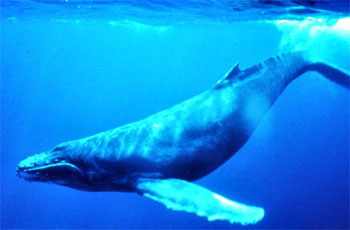 How many whales are enough? How many whales are enough? mongabay.com November 29, 2006 Iceland’s decision to resume hunting endangered fin whales raises an important question: how many whales are enough to sustain a population? While conservionists will debate over the actual number using varying models and population studies, a new paper published in the […]
How many whales are enough? How many whales are enough? mongabay.com November 29, 2006 Iceland’s decision to resume hunting endangered fin whales raises an important question: how many whales are enough to sustain a population? While conservionists will debate over the actual number using varying models and population studies, a new paper published in the […]
Whales share human brain cells
 Whales share human brain cells Whales share human brain cells mongabay.com November 27, 2006 Whales share brain cells with humans according to a new study published online November 27, 2006 in The Anatomical Record, the official journal of the American Association of Anatomists. The research suggests that “certain cetaceans and hominids may have evolved side […]
Whales share human brain cells Whales share human brain cells mongabay.com November 27, 2006 Whales share brain cells with humans according to a new study published online November 27, 2006 in The Anatomical Record, the official journal of the American Association of Anatomists. The research suggests that “certain cetaceans and hominids may have evolved side […]
Grey whales missing from traditional feeding grounds
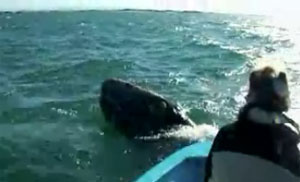 Grey whales missing from traditional feeding grounds Grey whales missing from traditional feeding grounds mongabay.com October 23, 2006 Researchers found few grey whales in their traditional feeding grounds in the North Pacific last summer according to a scientist at the University of Bath. Dr. William Megill, a professor of mechanical engineering with special interest in […]
Grey whales missing from traditional feeding grounds Grey whales missing from traditional feeding grounds mongabay.com October 23, 2006 Researchers found few grey whales in their traditional feeding grounds in the North Pacific last summer according to a scientist at the University of Bath. Dr. William Megill, a professor of mechanical engineering with special interest in […]
Dolphin Slaughter Resumes in Japan
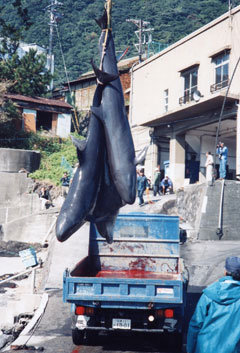 Dolphin Slaughter Resumes in Japan Dolphin Slaughter Resumes in Japan Renewed Dolphin Slaughter Prompts New Campaign WCS September 20, 2006 Group cites scientific and ethical justification for ending the hunts. As the annual dolphin drive hunts begin in the Japanese villages of Taiji and Futo, a consortium of scientists and zoo and aquarium professionals has […]
Dolphin Slaughter Resumes in Japan Dolphin Slaughter Resumes in Japan Renewed Dolphin Slaughter Prompts New Campaign WCS September 20, 2006 Group cites scientific and ethical justification for ending the hunts. As the annual dolphin drive hunts begin in the Japanese villages of Taiji and Futo, a consortium of scientists and zoo and aquarium professionals has […]
Ancient blue whale was a shark killer
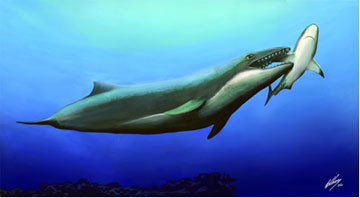 Ancient blue whale was a shark killer sharks, terrorized the seas Ancient blue whale was a shark killer Ancestor of baleen whales terrorized the seas mongabay.com August 21, 2006 A 25-million-year-old whale fossil from southeastern Australia suggests a curious origin for baleen whales. Presented at the at the Melbourne Museum last week, the fossil shows […]
Ancient blue whale was a shark killer sharks, terrorized the seas Ancient blue whale was a shark killer Ancestor of baleen whales terrorized the seas mongabay.com August 21, 2006 A 25-million-year-old whale fossil from southeastern Australia suggests a curious origin for baleen whales. Presented at the at the Melbourne Museum last week, the fossil shows […]
Norwegian killer whales most toxic mammals in Arctic
 Norwegian killer whales most toxic mammals in Arctic DetoXToxic chemicals: a threat to wildlife and animals Norwegian killer whales most toxic mammals in Arctic WWF News Release December 12, 2005 Gland, Swtizerland Initial scientific results show Norwegian killer whales are the most toxic mammals in the Arctic, says WWF, the global conservation organization. Previous […]
Norwegian killer whales most toxic mammals in Arctic DetoXToxic chemicals: a threat to wildlife and animals Norwegian killer whales most toxic mammals in Arctic WWF News Release December 12, 2005 Gland, Swtizerland Initial scientific results show Norwegian killer whales are the most toxic mammals in the Arctic, says WWF, the global conservation organization. Previous […]
Underwater sound pollution threat to marine life says new report
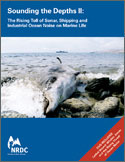 Underwater sound pollution threat to marine life says new report Underwater sound pollution threat to marine life says new report Natural Resources Defense Council release November 21, 2005 LOS ANGELES (November 21, 2005) — New evidence shows that the rising level of intense underwater sound produced by oil and gas exploration, military sonar and other […]
Underwater sound pollution threat to marine life says new report Underwater sound pollution threat to marine life says new report Natural Resources Defense Council release November 21, 2005 LOS ANGELES (November 21, 2005) — New evidence shows that the rising level of intense underwater sound produced by oil and gas exploration, military sonar and other […]
Whale uses fish as bait to catch seagulls then shares strategy with fellow orcas
Whale uses fish as bait to catch seagulls then shares strategy with fellow orcas Whale uses fish as bait to catch seagulls then shares strategy with fellow orcas AP September 7, 2005 NIAGARA FALLS, Ontario – An enterprising young killer whale at Marineland has figured out how to use fish as bait to catch seagulls […]
Humpback whale tracked migrating between ocean basins
 Humpback whale tracked migrating between ocean basins Humpback whale tracked migrating between ocean basins .ongabay.com August 18, 2005 Humpback Whale. Image courtesy of NOAA. Background from Wikipedia.org: The Humpback Whale (Megaptera novaeangliae) is a large whale (up to 50 feet [16m] long) found in oceans worldwide. The Humpback is well known its haunting whale song. […]
Humpback whale tracked migrating between ocean basins Humpback whale tracked migrating between ocean basins .ongabay.com August 18, 2005 Humpback Whale. Image courtesy of NOAA. Background from Wikipedia.org: The Humpback Whale (Megaptera novaeangliae) is a large whale (up to 50 feet [16m] long) found in oceans worldwide. The Humpback is well known its haunting whale song. […]
Feeds: news | india | latam | brasil | indonesia
 Recent top stories from our Spanish-language service, Mongabay-Latam, revealed Peruvians’ hidden shark diet, new species in Colombia’s Chiribiquete National Park, dire predictions from Mexico’s “Batman,” and more. Peruvians are eating shark and don’t know it Three out of four Peruvians recently surveyed were found to have eaten shark meat without knowing it. The problem stems […]
Recent top stories from our Spanish-language service, Mongabay-Latam, revealed Peruvians’ hidden shark diet, new species in Colombia’s Chiribiquete National Park, dire predictions from Mexico’s “Batman,” and more. Peruvians are eating shark and don’t know it Three out of four Peruvians recently surveyed were found to have eaten shark meat without knowing it. The problem stems […] A New Zealand dolphin, one of whose two subspecies, the Maui’s dolphin, is critically endangered with a quickly diminishing population. Photo credit: Steve Dawson/NABU International Foundation for Nature. Maui’s dolphins (Cephalorhynchus hectori maui) are edging closer to extinction. Strikingly marked, with a dark, rounded dorsal fin that has been likened to a Mickey Mouse ear, […]
A New Zealand dolphin, one of whose two subspecies, the Maui’s dolphin, is critically endangered with a quickly diminishing population. Photo credit: Steve Dawson/NABU International Foundation for Nature. Maui’s dolphins (Cephalorhynchus hectori maui) are edging closer to extinction. Strikingly marked, with a dark, rounded dorsal fin that has been likened to a Mickey Mouse ear, […] A fisherman hauls up a critically endangered vaquita porpoise accidentally entangled in his net in 2008. Entanglement in fishing gear threatens the species with extinction. Photo credit: Omar Vidal. With fewer than 100 individuals alive and dropping fast, the vaquita porpoise is just a swish of the tail away from extinction. In April, alerted by […]
A fisherman hauls up a critically endangered vaquita porpoise accidentally entangled in his net in 2008. Entanglement in fishing gear threatens the species with extinction. Photo credit: Omar Vidal. With fewer than 100 individuals alive and dropping fast, the vaquita porpoise is just a swish of the tail away from extinction. In April, alerted by […] Vaquitas (Phocoena sinus) are more solitary than other cetacean species, but are sometimes found in small groups. Photo by: Paula Olson, NOAA. There are likely less than 100 vaquita (Phocoena sinus) on the planet. Found only in the northern pocket of the Sea of Cortez in Mexico, the vaquita is a tiny, shy porpoise that […]
Vaquitas (Phocoena sinus) are more solitary than other cetacean species, but are sometimes found in small groups. Photo by: Paula Olson, NOAA. There are likely less than 100 vaquita (Phocoena sinus) on the planet. Found only in the northern pocket of the Sea of Cortez in Mexico, the vaquita is a tiny, shy porpoise that […] Fishing industry propelling tiny cetacean to extinction Since the baiji was declared extinct in the early aughts, the vaquita has taken its unenviable position as the world’s most threatened cetacean. The tiny porpoise currently numbers around 100, with accidental entanglement in gillnets primarily responsible for its decline. In response, the IUCN recently issued a statement […]
Fishing industry propelling tiny cetacean to extinction Since the baiji was declared extinct in the early aughts, the vaquita has taken its unenviable position as the world’s most threatened cetacean. The tiny porpoise currently numbers around 100, with accidental entanglement in gillnets primarily responsible for its decline. In response, the IUCN recently issued a statement […].600.jpg) Norway has its biggest minke whaling season in over 20 years. As of late August, Norway has killed 729 northern minke whales (Balaenoptera acutorostrata) during its annual whaling season, the highest number taken since 1993. Norway continues whaling by having filed an “objection” under the International Whaling Commission (IWC), which has banned whaling worldwide aside […]
Norway has its biggest minke whaling season in over 20 years. As of late August, Norway has killed 729 northern minke whales (Balaenoptera acutorostrata) during its annual whaling season, the highest number taken since 1993. Norway continues whaling by having filed an “objection” under the International Whaling Commission (IWC), which has banned whaling worldwide aside […] California or North Pacific Blue Whales can exceed 100 feet (30m) long and weigh 190 tons. Photo courtesy of Gilpatrick/Lynn/NOAA The population of blue whales in the Eastern Pacific has recovered to 97 percent of historic levels decades after Earth’s largest animal was nearly driven to extinction in some places due to the whaling industry, […]
California or North Pacific Blue Whales can exceed 100 feet (30m) long and weigh 190 tons. Photo courtesy of Gilpatrick/Lynn/NOAA The population of blue whales in the Eastern Pacific has recovered to 97 percent of historic levels decades after Earth’s largest animal was nearly driven to extinction in some places due to the whaling industry, […] Southern elephant seals battle for mating rights. Photo by: G. Harris/WCS. Conservationists are celebrating the announcement that UNESCO has dubbed Argentina’s Península Valdés a biosphere reserve under the Man and Biosphere Program (MBA). A hatchet-shaped peninsula that juts out into the Southern Atlantic Ocean, the world’s newest biosphere reserve is home to a hugely-diverse collection […]
Southern elephant seals battle for mating rights. Photo by: G. Harris/WCS. Conservationists are celebrating the announcement that UNESCO has dubbed Argentina’s Península Valdés a biosphere reserve under the Man and Biosphere Program (MBA). A hatchet-shaped peninsula that juts out into the Southern Atlantic Ocean, the world’s newest biosphere reserve is home to a hugely-diverse collection […] Although whales are the biggest animals on the planet, scientists have found in difficult to count them. But a new study in PLOS ONE may change this: researchers tested the idea of counting whales using high resolution satellite imagery. Employing a single image from the WorldView2 satellite, scientists went about counting a pod of southern […]
Although whales are the biggest animals on the planet, scientists have found in difficult to count them. But a new study in PLOS ONE may change this: researchers tested the idea of counting whales using high resolution satellite imagery. Employing a single image from the WorldView2 satellite, scientists went about counting a pod of southern […] Researchers have described a new beaked whale species. The beaked whale family, so-called for their dolphin-like beaks, are among the world’s least known mammals. This photo shows a Blainville’s beaked whale (Mesoplodon densirostris). Photo by: NOAA. Beaked whales are incredibly elusive and rare, little-known to scientists and the public alike—although some species are three times […]
Researchers have described a new beaked whale species. The beaked whale family, so-called for their dolphin-like beaks, are among the world’s least known mammals. This photo shows a Blainville’s beaked whale (Mesoplodon densirostris). Photo by: NOAA. Beaked whales are incredibly elusive and rare, little-known to scientists and the public alike—although some species are three times […] Taiji fisherman capturing a bottlenose dolphin. Photo courtesy of Sea Shepherd The annual dolphin hunt in Taiji, Japan ended on Monday with dozens being slaughtered for meat and captured for sale to amusement parks, reports Sea Shepherd, an ocean activist group that campaigns against the practice and released photos documenting the weekend’s harvest. Last week […]
Taiji fisherman capturing a bottlenose dolphin. Photo courtesy of Sea Shepherd The annual dolphin hunt in Taiji, Japan ended on Monday with dozens being slaughtered for meat and captured for sale to amusement parks, reports Sea Shepherd, an ocean activist group that campaigns against the practice and released photos documenting the weekend’s harvest. Last week […] Three dead minke whales photographed by Sea Shepherd’s helicopter. Courtesy of Sea Shepherd Australia. Anti-whaling group Sea Shepherd said its fleet of ships has successfully disrupted the annual Japanese whale hunt in the waters off Antarctica. “After a 360-mile chase, The Sea Shepherd Fleet drove the Japanese whaling fleet’s factory ship, the Nisshin Maru, out […]
Three dead minke whales photographed by Sea Shepherd’s helicopter. Courtesy of Sea Shepherd Australia. Anti-whaling group Sea Shepherd said its fleet of ships has successfully disrupted the annual Japanese whale hunt in the waters off Antarctica. “After a 360-mile chase, The Sea Shepherd Fleet drove the Japanese whaling fleet’s factory ship, the Nisshin Maru, out […] Orca at SeaWorld. Courtesy of Blackfish. More than 27,000 people have signed a petition calling on Southwest Airlines Co. (NYSE:LUV) to drop its partnership with SeaWorld Entertainment, Inc. (NYSE:SEAS), over the theme park’s treatment of its marine mammals, reports Change.org, the site that is hosting the petition. The petition urges Southwest to end its marketing […]
Orca at SeaWorld. Courtesy of Blackfish. More than 27,000 people have signed a petition calling on Southwest Airlines Co. (NYSE:LUV) to drop its partnership with SeaWorld Entertainment, Inc. (NYSE:SEAS), over the theme park’s treatment of its marine mammals, reports Change.org, the site that is hosting the petition. The petition urges Southwest to end its marketing […].600.jpg) With the help of DNA tests, scientists have declared a new dolphin species that dwells off the coast of northern Australia. The discovery was made after a team of researchers looked at the world’s humpback dolphins (in the genus Sousa), which sport telltale humps just behind their dorsal fins. While long-known to science, the new, […]
With the help of DNA tests, scientists have declared a new dolphin species that dwells off the coast of northern Australia. The discovery was made after a team of researchers looked at the world’s humpback dolphins (in the genus Sousa), which sport telltale humps just behind their dorsal fins. While long-known to science, the new, […] Peruvian fishermen slaughtered dolphins to use as bait for shark fishing, an undercover investigation has revealed. Footage showed infant and adult dolphins being harpooned then stabbed and clubbed before, in some cases, being cut open and butchered while still alive. The slaughtered dolphins were cut up and used as bait. Dolphins are also killed for […]
Peruvian fishermen slaughtered dolphins to use as bait for shark fishing, an undercover investigation has revealed. Footage showed infant and adult dolphins being harpooned then stabbed and clubbed before, in some cases, being cut open and butchered while still alive. The slaughtered dolphins were cut up and used as bait. Dolphins are also killed for […] An oil company’s use of a high-frequency mapping sonar system was responsible for a mass whale stranding in northwest Madagascar in 2008, finds a new report. The report, issued today by an independent scientific review panel, found that the stranding of roughly 100 melon-headed whales was “primarily triggered” by seismic testing conducted by an ExxonMobil […]
An oil company’s use of a high-frequency mapping sonar system was responsible for a mass whale stranding in northwest Madagascar in 2008, finds a new report. The report, issued today by an independent scientific review panel, found that the stranding of roughly 100 melon-headed whales was “primarily triggered” by seismic testing conducted by an ExxonMobil […] It sounds ludicrous, but it could just be true: scientists say seagulls may be responsible for hundreds of southern right whale mortalities off the Argentine coastline. Since 2003, scientists have documented the deaths of 605 southern right whales (Eubalaena australis) near Península Valdés which the whales use as a nursery. Notably, 88 percent of these […]
It sounds ludicrous, but it could just be true: scientists say seagulls may be responsible for hundreds of southern right whale mortalities off the Argentine coastline. Since 2003, scientists have documented the deaths of 605 southern right whales (Eubalaena australis) near Península Valdés which the whales use as a nursery. Notably, 88 percent of these […] Inside Moby-Dick’s stomach, there’s a lot more than Ahab’s leg. What do children’s toys, balloons, mattresses and plastic bags have in common? They can, along with more non-biodegradable pollutants, be found in the belly of a sperm whale, the topic of a new study in the Marine Pollution Bulletin. The same whale that swallowed Jonah […]
Inside Moby-Dick’s stomach, there’s a lot more than Ahab’s leg. What do children’s toys, balloons, mattresses and plastic bags have in common? They can, along with more non-biodegradable pollutants, be found in the belly of a sperm whale, the topic of a new study in the Marine Pollution Bulletin. The same whale that swallowed Jonah […] Japan blamed environmental activists for a “record low” take during this year’s whaling season in the Southern Ocean, reports Kyodo News. Agriculture, Forestry and Fisheries Minister Yoshimasa Hayashi said the recent hunt yielded only 103 Antarctic minke whales and no fin whales, according to the agency’s web site. The target had been 1,000 whales for […]
Japan blamed environmental activists for a “record low” take during this year’s whaling season in the Southern Ocean, reports Kyodo News. Agriculture, Forestry and Fisheries Minister Yoshimasa Hayashi said the recent hunt yielded only 103 Antarctic minke whales and no fin whales, according to the agency’s web site. The target had been 1,000 whales for […] Photo of the ‘super mega-pod’ by Antonio Ramirez, a passenger aboard the Hornblower Cruise that spotted the dolphins last Thursday. A ‘super mega-pod’ of some 100,000 dolphins was spotted off the coast of San Diego last week, according to a report from NBC San Diego. The giant pod of common dolphins (Delphinus delphis) was sighted […]
Photo of the ‘super mega-pod’ by Antonio Ramirez, a passenger aboard the Hornblower Cruise that spotted the dolphins last Thursday. A ‘super mega-pod’ of some 100,000 dolphins was spotted off the coast of San Diego last week, according to a report from NBC San Diego. The giant pod of common dolphins (Delphinus delphis) was sighted […] The 3rd Annual New York Wildlife Conservation Film Festival (WFCC.org) runs from January 30 – February 2, 2013. Ahead of the event, Mongabay.com is running a series of Q&As with filmmakers and presenters. For more interviews, please see our WCFF feed. Through his new 90-second PSA, Save Lolita, filmmaker Daniel Azarian wanted to connect people […]
The 3rd Annual New York Wildlife Conservation Film Festival (WFCC.org) runs from January 30 – February 2, 2013. Ahead of the event, Mongabay.com is running a series of Q&As with filmmakers and presenters. For more interviews, please see our WCFF feed. Through his new 90-second PSA, Save Lolita, filmmaker Daniel Azarian wanted to connect people […] Hector’s dolphin, the parent species of the Maui’s dolphin. Photo by: James Shook. The New Zealand government’s recent efforts to protect the world’s smallest dolphin have come under scrutiny from various conservation organizations at the 64th meeting of the International Whaling Commission (IWC). There are only 55 Maui dolphins (Cephalorhynchus hectori maui) now found on […]
Hector’s dolphin, the parent species of the Maui’s dolphin. Photo by: James Shook. The New Zealand government’s recent efforts to protect the world’s smallest dolphin have come under scrutiny from various conservation organizations at the 64th meeting of the International Whaling Commission (IWC). There are only 55 Maui dolphins (Cephalorhynchus hectori maui) now found on […] Humpback whale. Photo by Rhett A. Butler Humpback whales in the Antarctic are delaying their migration to feed on krill that are staying later due to reduced extent of sea ice, a possible consequence of climate change, reports a study published in the journal Endangered Species Research [PDF. The research, which was led by David […]
Humpback whale. Photo by Rhett A. Butler Humpback whales in the Antarctic are delaying their migration to feed on krill that are staying later due to reduced extent of sea ice, a possible consequence of climate change, reports a study published in the journal Endangered Species Research [PDF. The research, which was led by David […] Researcher with dead dolphin calf. Photo courtesy of the University of Central Florida. In the first four months of 2011, 186 bottlenose dolphins (Tursiops truncatus) were found dead in the Gulf of Mexico, nearly half of them dolphin calves many of whom were perinatal, or near birth. Researchers now believe a number of factors may […]
Researcher with dead dolphin calf. Photo courtesy of the University of Central Florida. In the first four months of 2011, 186 bottlenose dolphins (Tursiops truncatus) were found dead in the Gulf of Mexico, nearly half of them dolphin calves many of whom were perinatal, or near birth. Researchers now believe a number of factors may […] There are two subspecies of the finless porpoise, one is found in the Yangtze River, the other in Japan, Taiwan, and South Korea. This individual is the latter and was photographed in a Japanese aquarium. Photo by: Kenichi Nobusue. Six years after the Yangtze river dolphin (Lipotes vexillifer), or baiji, was declared “functionally extinct” by […]
There are two subspecies of the finless porpoise, one is found in the Yangtze River, the other in Japan, Taiwan, and South Korea. This individual is the latter and was photographed in a Japanese aquarium. Photo by: Kenichi Nobusue. Six years after the Yangtze river dolphin (Lipotes vexillifer), or baiji, was declared “functionally extinct” by […] Hector’s dolphin is the parent species of the subspecies Maui’s dolphin. Both are only found in New Zealand. Photo by: Bigstock. The world’s smallest dolphin is also the closest to extinction. New Zealand government figures show that Maui’s dolphin (Cephalorhynchus hectori maui) are down to just 55 mature individuals, falling from 111 in 2005. The […]
Hector’s dolphin is the parent species of the subspecies Maui’s dolphin. Both are only found in New Zealand. Photo by: Bigstock. The world’s smallest dolphin is also the closest to extinction. New Zealand government figures show that Maui’s dolphin (Cephalorhynchus hectori maui) are down to just 55 mature individuals, falling from 111 in 2005. The […] Amazon Japan, a subsidiary of Amazon.com, pulled all whale meat products (and possibly dolphin meat) from its site after a new report by the Environmental Investigation Agency (EIA) and the Humane Society International highlighted the issue. Last December the organizations recorded 147 whale products on sale at Amazon Japan despite an international whaling moratorium since […]
Amazon Japan, a subsidiary of Amazon.com, pulled all whale meat products (and possibly dolphin meat) from its site after a new report by the Environmental Investigation Agency (EIA) and the Humane Society International highlighted the issue. Last December the organizations recorded 147 whale products on sale at Amazon Japan despite an international whaling moratorium since […] Ganges River dolphin in the Sundarbans. Photo by: Rubaiyat Mansur. Bangladesh has declared three new sanctuaries to help protect the south Asian river dolphin (Platanista gangetica) in the Sundarbans, the world’s largest mangrove forest. Split into two subspecies, the Ganges River dolphin (Platanista gangetica gangetica) and the Irrawaddy River dolphin (Platanista gangetica minor), the new […]
Ganges River dolphin in the Sundarbans. Photo by: Rubaiyat Mansur. Bangladesh has declared three new sanctuaries to help protect the south Asian river dolphin (Platanista gangetica) in the Sundarbans, the world’s largest mangrove forest. Split into two subspecies, the Ganges River dolphin (Platanista gangetica gangetica) and the Irrawaddy River dolphin (Platanista gangetica minor), the new […] Local fishers in Brazzaville in the Republic of Congo with a butchered Atlantic humpback dolphin, a West African endemic that has been extirpated from much of its range as fisheries decline and people shift to other sources of protein. Photo by: Tim Collins. Threats to marine mammals usually include climate change, drowning as by-catch, pollution, […]
Local fishers in Brazzaville in the Republic of Congo with a butchered Atlantic humpback dolphin, a West African endemic that has been extirpated from much of its range as fisheries decline and people shift to other sources of protein. Photo by: Tim Collins. Threats to marine mammals usually include climate change, drowning as by-catch, pollution, […] Minke whale kabob served up at the Sea Baron restaurant in Reykjavik Harbour area, Iceland. Photo by:Thjurexoell. How do you end a decades-long conflict between culture and conservation? How do you stop a conflict where both sides are dug in? A new paper in Nature proposes a way to end the long and bitter battle […]
Minke whale kabob served up at the Sea Baron restaurant in Reykjavik Harbour area, Iceland. Photo by:Thjurexoell. How do you end a decades-long conflict between culture and conservation? How do you stop a conflict where both sides are dug in? A new paper in Nature proposes a way to end the long and bitter battle […] Singa betina mempertahankan wildebeest yang terbunuh di Tanzania. Foto oleh: Rhett A. Butler. Populasi serigala di seluruh dunia telah turun sekitar 99 persen dari jumlah populasi yang pernah ada dalam sejarah. Populasi singa jatuh dari 450.000 menjadi 20.000 dalam 50 tahun. Tiga subspesies harimau punah di abad ke-20. Penangkapan ikan yang berlebihan dan pemotongan sirip […]
Singa betina mempertahankan wildebeest yang terbunuh di Tanzania. Foto oleh: Rhett A. Butler. Populasi serigala di seluruh dunia telah turun sekitar 99 persen dari jumlah populasi yang pernah ada dalam sejarah. Populasi singa jatuh dari 450.000 menjadi 20.000 dalam 50 tahun. Tiga subspesies harimau punah di abad ke-20. Penangkapan ikan yang berlebihan dan pemotongan sirip […] Researchers have discovered a new species of dolphin in Australia, reports ABC News. Analysis of bottlenose dolphins in Port Philip and the Gippsland Lakes in Southeastern Australia revealed them to be declared a new species. “This is an incredibly fascinating discovery as there have only been three new dolphin species formally described and recognised since […]
Researchers have discovered a new species of dolphin in Australia, reports ABC News. Analysis of bottlenose dolphins in Port Philip and the Gippsland Lakes in Southeastern Australia revealed them to be declared a new species. “This is an incredibly fascinating discovery as there have only been three new dolphin species formally described and recognised since […] Lioness defends wildebeest kill in Tanzania. Photo by: Rhett A. Butler. Worldwide wolf populations have dropped around 99 percent from historic populations. Lion populations have fallen from 450,000 to 20,000 in 50 years. Three subspecies of tiger went extinct in the 20th Century. Overfishing and finning has cut some shark populations down by 90 percent […]
Lioness defends wildebeest kill in Tanzania. Photo by: Rhett A. Butler. Worldwide wolf populations have dropped around 99 percent from historic populations. Lion populations have fallen from 450,000 to 20,000 in 50 years. Three subspecies of tiger went extinct in the 20th Century. Overfishing and finning has cut some shark populations down by 90 percent […] The Indian government has announced that it plans to develop a program to raise the population of its native Ganges river dolphin (Platanista gangetica gagnetica), a subspecies of the South Asian river dolphin. During a question and answer session Jairam Ramesh, India’s Environment and Forests Minister, said that the dolphin’s current population was estimated at […]
The Indian government has announced that it plans to develop a program to raise the population of its native Ganges river dolphin (Platanista gangetica gagnetica), a subspecies of the South Asian river dolphin. During a question and answer session Jairam Ramesh, India’s Environment and Forests Minister, said that the dolphin’s current population was estimated at […] A new project sponsored by Nokia uses KAPing – kite aerial photography – to get an innovative look at whale behavior. The project will be taking place in Hawaii and will document the area’s annual humpback whale migration. KAPing uses kites to suspend cameras, providing a birds-eye view of a scene without need for a […]
A new project sponsored by Nokia uses KAPing – kite aerial photography – to get an innovative look at whale behavior. The project will be taking place in Hawaii and will document the area’s annual humpback whale migration. KAPing uses kites to suspend cameras, providing a birds-eye view of a scene without need for a […] Japan’s dolphin hunt of Dall’s porpoise (Phocoenoides dalli) could be making people sick, according to a new study by the Environmental Investigation Agency (EIA) and Campaign Whale. The controversial hunt, which kills some 15,000 dolphins annually, produces cheap meat-for-consumption that on average contains over double Japan’s limit on mercury contamination. “We are very concerned that […]
Japan’s dolphin hunt of Dall’s porpoise (Phocoenoides dalli) could be making people sick, according to a new study by the Environmental Investigation Agency (EIA) and Campaign Whale. The controversial hunt, which kills some 15,000 dolphins annually, produces cheap meat-for-consumption that on average contains over double Japan’s limit on mercury contamination. “We are very concerned that […] Dolphins, whales, and dugongs will be safe from hunting in the waters surrounding the Pacific nation of Palau. At the Convention on Biological Diversity (CBD) in Nagoya, Japan, Palau’s Minister of the Environment, Natural Resources and Tourism, Harry Fritz, announced the establishment of a marine mammal sanctuary covering over 230,000 square miles (600,000 square kilometers) […]
Dolphins, whales, and dugongs will be safe from hunting in the waters surrounding the Pacific nation of Palau. At the Convention on Biological Diversity (CBD) in Nagoya, Japan, Palau’s Minister of the Environment, Natural Resources and Tourism, Harry Fritz, announced the establishment of a marine mammal sanctuary covering over 230,000 square miles (600,000 square kilometers) […] Communal photo sharing site, Flickr, has allowed researchers to discover the longest migration by a whale yet recorded. Ten years ago a female humpback whale swam from Brazil to Madagascar, covering around 6,090 miles (9,800 kilometers). The migration tops the previous record by 2,485 miles (4,000 kilometers). Not only is this a record for a […]
Communal photo sharing site, Flickr, has allowed researchers to discover the longest migration by a whale yet recorded. Ten years ago a female humpback whale swam from Brazil to Madagascar, covering around 6,090 miles (9,800 kilometers). The migration tops the previous record by 2,485 miles (4,000 kilometers). Not only is this a record for a […] Most of the US’s large ecosystems are but shadows of their former selves. The old-growth deciduous forests that once covered nearly all of the east and mid-west continental US are gone, reduced to a few fragmented patches that are still being lost. The tall grassy plains that once stretched further than any eye could see […]
Most of the US’s large ecosystems are but shadows of their former selves. The old-growth deciduous forests that once covered nearly all of the east and mid-west continental US are gone, reduced to a few fragmented patches that are still being lost. The tall grassy plains that once stretched further than any eye could see […] The International Union for the Conservation of Nature (IUCN) has released a list of ten species that are likely to be among the hardest hit by climate change, including beloved species such as the leatherback sea turtle, the koala, the emperor penguin, the clownfish, and the beluga whale. The timing of the list coincides with […]
The International Union for the Conservation of Nature (IUCN) has released a list of ten species that are likely to be among the hardest hit by climate change, including beloved species such as the leatherback sea turtle, the koala, the emperor penguin, the clownfish, and the beluga whale. The timing of the list coincides with […] The importance of a whale to the oceanic ecosystem does not end with its life. After dying, a whale’s body sinks to the bottom of the ocean and becomes food for many species, some of whom specialize on feeding on these corpses. Using underwater cameras, researchers with the University of Gothenburg, Sweden have discovered nine […]
The importance of a whale to the oceanic ecosystem does not end with its life. After dying, a whale’s body sinks to the bottom of the ocean and becomes food for many species, some of whom specialize on feeding on these corpses. Using underwater cameras, researchers with the University of Gothenburg, Sweden have discovered nine […] The Ganges River Dolphin faces a high risk of extinction in India’s Brahmaputra river system unless critical habitat is protected, report conservationists. Once abundant in the Ganges and Brahmaputra river systems in India and Bangladesh, the population of the Ganges River Dolphins has fallen sharply over the past century due to accidental bycatch by fishermen, […]
The Ganges River Dolphin faces a high risk of extinction in India’s Brahmaputra river system unless critical habitat is protected, report conservationists. Once abundant in the Ganges and Brahmaputra river systems in India and Bangladesh, the population of the Ganges River Dolphins has fallen sharply over the past century due to accidental bycatch by fishermen, […] Supreme Court lifts ban on sonar testing, whales lose Supreme Court lifts ban on sonar testing, whales lose mongabay.com November 12, 2008 Bad news for whales as the Supreme Court rules military exercises can resume off the coast of California. Court doesn’t weigh in on the ecological impacts of testing, but the process lower courts […]
Supreme Court lifts ban on sonar testing, whales lose Supreme Court lifts ban on sonar testing, whales lose mongabay.com November 12, 2008 Bad news for whales as the Supreme Court rules military exercises can resume off the coast of California. Court doesn’t weigh in on the ecological impacts of testing, but the process lower courts […] U.S., Mexico, Canada pledge to save the vaquita from extinction U.S., Mexico, Canada pledge to save the vaquita from extinction mongabay.com October 30, 2008 Last stand for the world’s smallest and rarest porpoise
U.S., Mexico, Canada pledge to save the vaquita from extinction U.S., Mexico, Canada pledge to save the vaquita from extinction mongabay.com October 30, 2008 Last stand for the world’s smallest and rarest porpoise Argentina bans fishing, trawling in eco-rich area Argentina bans fishing, trawling in eco-rich area mongabay.com October 9, 2008
Argentina bans fishing, trawling in eco-rich area Argentina bans fishing, trawling in eco-rich area mongabay.com October 9, 2008 IWC issues media blackout on discussions to lift whaling ban IWC issues media blackout on discussions to lift whaling ban Jeremey Hance, mongabay.com September 11, 2008 The fate of the ban on whale hunting to be decided behind closed doors The survival of whales is perhaps the most successful conservation story of the 20th century. […]
IWC issues media blackout on discussions to lift whaling ban IWC issues media blackout on discussions to lift whaling ban Jeremey Hance, mongabay.com September 11, 2008 The fate of the ban on whale hunting to be decided behind closed doors The survival of whales is perhaps the most successful conservation story of the 20th century. […] The extinction of the baiji a ‘wake-up call’ to conserve vaquita and other cetaceans An interview with Dr. Jay Barlow: Extinction of the baiji a ‘wake-up call’ to conserve vaquita and other cetaceans Jeremy Hance, mongabay.com August 25, 2008 In December of 2006 an expedition spent six weeks surveying the Yangtze River in China for […]
The extinction of the baiji a ‘wake-up call’ to conserve vaquita and other cetaceans An interview with Dr. Jay Barlow: Extinction of the baiji a ‘wake-up call’ to conserve vaquita and other cetaceans Jeremy Hance, mongabay.com August 25, 2008 In December of 2006 an expedition spent six weeks surveying the Yangtze River in China for […] This year has been full of bad news regarding marine ecosystems: one-third of coral species threatened with extinction, dead-zones spread to 415 sites, half of U.S. reefs in fair or bad condition, increase in ocean acidification, tuna and shark populations collapsing, and only four percent of ocean considered pristine. Jeremy Jackson, director of the Scripps […]
This year has been full of bad news regarding marine ecosystems: one-third of coral species threatened with extinction, dead-zones spread to 415 sites, half of U.S. reefs in fair or bad condition, increase in ocean acidification, tuna and shark populations collapsing, and only four percent of ocean considered pristine. Jeremy Jackson, director of the Scripps […] Whale biomimicry inspires better wind turbines Whale biomimicry inspires better wind turbines mongabay.com July 7, 2008 By studying and mimicking the characteristics of the flippers, fins and tails of whales and dolphins, engineers have devised more a efficient way to generate wind power, reports a researcher presenting at the Society for Experimental Biology’s Annual Meeting […]
Whale biomimicry inspires better wind turbines Whale biomimicry inspires better wind turbines mongabay.com July 7, 2008 By studying and mimicking the characteristics of the flippers, fins and tails of whales and dolphins, engineers have devised more a efficient way to generate wind power, reports a researcher presenting at the Society for Experimental Biology’s Annual Meeting […] New species of river dolphin discovered in the Amazon New species of river dolphin discovered in the Amazon mongabay.com April 30, 2008 Researchers have identified a new species of river dolphin in the Bolivian Amazon according to the Whale and Dolphin Conservation Society (WDCS). The announcement was made at a conservation workshop in Santa Cruz […]
New species of river dolphin discovered in the Amazon New species of river dolphin discovered in the Amazon mongabay.com April 30, 2008 Researchers have identified a new species of river dolphin in the Bolivian Amazon according to the Whale and Dolphin Conservation Society (WDCS). The announcement was made at a conservation workshop in Santa Cruz […] The Arctic’s most threatened marine mammals due to climate change The Arctic’s most threatened marine mammals due to climate change Jeremy Hance, mongabay.com April 25, 2008 A recent study has measured the sensitivity to Arctic marine mammals to climate change. The study found that the three species most vulnerable to climate change are the hooded […]
The Arctic’s most threatened marine mammals due to climate change The Arctic’s most threatened marine mammals due to climate change Jeremy Hance, mongabay.com April 25, 2008 A recent study has measured the sensitivity to Arctic marine mammals to climate change. The study found that the three species most vulnerable to climate change are the hooded […] Japan cancels plan to kill 50 humpback whales Japan cancels plan to kill 50 humpback whales mongabay.com December 21, 2007 Japan has canceled highly controversial plans to kill 50 humpback whales for purported “scietific purposes” (the meat is sold in fish markets) after widespread condemnation from environmentalists and governments. The decision comes shortly following Australia’s […]
Japan cancels plan to kill 50 humpback whales Japan cancels plan to kill 50 humpback whales mongabay.com December 21, 2007 Japan has canceled highly controversial plans to kill 50 humpback whales for purported “scietific purposes” (the meat is sold in fish markets) after widespread condemnation from environmentalists and governments. The decision comes shortly following Australia’s […] Evolution of whales challenged Origin of whales challenged mongabay.com December 19, 2007 Modern whales appear to have evolved from a raccoon-sized creature with the body of a small deer, according to scientists writing in the journal Nature. The results challenge the theory that cetaceans are descended from even-toed ungulates (artiodactyls) like hippos, as previous molecular […]
Evolution of whales challenged Origin of whales challenged mongabay.com December 19, 2007 Modern whales appear to have evolved from a raccoon-sized creature with the body of a small deer, according to scientists writing in the journal Nature. The results challenge the theory that cetaceans are descended from even-toed ungulates (artiodactyls) like hippos, as previous molecular […] Only 150 vaquita remain Only 150 vaquita remain mongabay.com November 19, 2007 Only 150 individual vaquita, the world’s smallest cetacean, remain, according to a new study published in Conservation Biology. The species has been decimated as accidental bycatch in fishing nets in its Gulf of California habitat. Researchers–who say there may be only a two-year […]
Only 150 vaquita remain Only 150 vaquita remain mongabay.com November 19, 2007 Only 150 individual vaquita, the world’s smallest cetacean, remain, according to a new study published in Conservation Biology. The species has been decimated as accidental bycatch in fishing nets in its Gulf of California habitat. Researchers–who say there may be only a two-year […] Picture: Whale stranded 1,000 miles up the Amazon river Picture: Whale stranded 1,000 miles up the Amazon river mongabay.com November 17, 2007 An 18-foot minke whale was found beached on a sandbar 1,000 miles up a tributary of the Amazon river, reported Globo television and the Associated Press. Rescuers were sent to dislodge the marine […]
Picture: Whale stranded 1,000 miles up the Amazon river Picture: Whale stranded 1,000 miles up the Amazon river mongabay.com November 17, 2007 An 18-foot minke whale was found beached on a sandbar 1,000 miles up a tributary of the Amazon river, reported Globo television and the Associated Press. Rescuers were sent to dislodge the marine […] Apology for Whale Shooting given by Tribe Apology for Whale Shooting given by Tribe Joshua Hill September 13, 2007 The ninth of September saw a gray whale shot and killed by members of the Makah Tribe, off the coast of the Washington Coast, in the Strait of Juan de Fuca. From a report by the […]
Apology for Whale Shooting given by Tribe Apology for Whale Shooting given by Tribe Joshua Hill September 13, 2007 The ninth of September saw a gray whale shot and killed by members of the Makah Tribe, off the coast of the Washington Coast, in the Strait of Juan de Fuca. From a report by the […] Global warming affects whale populations already reduced by historic whaling Gray whale populations only a fraction of historic level mongabay.com September 10, 2007 The current population of gray whales is one-third to one-fifth of the number found in the Pacific before industrial whaling began in the 19th century, reports a new study based on genetic […]
Global warming affects whale populations already reduced by historic whaling Gray whale populations only a fraction of historic level mongabay.com September 10, 2007 The current population of gray whales is one-third to one-fifth of the number found in the Pacific before industrial whaling began in the 19th century, reports a new study based on genetic […] Squid chasing drove eolution of whale sonar Squid chasing drove eolution of whale sonar University of California – Berkeley September 6, 2007 A University of California at Berkeley study argues that dolphins and other toothed whales developed sonar to chase schools of squid swimming near the ocean surface at night. Behind the sailor’s lore of […]
Squid chasing drove eolution of whale sonar Squid chasing drove eolution of whale sonar University of California – Berkeley September 6, 2007 A University of California at Berkeley study argues that dolphins and other toothed whales developed sonar to chase schools of squid swimming near the ocean surface at night. Behind the sailor’s lore of […] Rare Chinese river dolphin sighting in doubt Rare Chinese river dolphin sighting in question mongabay.com September 1, 2007 A prominent researcher is skeptical of last week’s reported sighting of the baiji, the Chinese river dolphin declared extinct earlier this year, according to the New York Times. The sighting near Tongling city in Anhui Province — […]
Rare Chinese river dolphin sighting in doubt Rare Chinese river dolphin sighting in question mongabay.com September 1, 2007 A prominent researcher is skeptical of last week’s reported sighting of the baiji, the Chinese river dolphin declared extinct earlier this year, according to the New York Times. The sighting near Tongling city in Anhui Province — […] Saving beautiful – and ugly – species from extinction Saving the beautiful – and the ugly – creatures of the world Why the EDGE Matters Jeremy Hance August 30, 2007 Allow me to wax poetic about the world’s newest wildlife organization, EDGE. I must admit I’m a little in love. This singular organization was founded […]
Saving beautiful – and ugly – species from extinction Saving the beautiful – and the ugly – creatures of the world Why the EDGE Matters Jeremy Hance August 30, 2007 Allow me to wax poetic about the world’s newest wildlife organization, EDGE. I must admit I’m a little in love. This singular organization was founded […] “Extinct” baiji river dolphin spotted alive in China “Extinct” baiji river dolphin spotted alive in China mongabay.com August 29, 2007 An “extinct” baiji has been spotted alive in the Yangtze River, reports Chinese state media. The freshwater dolphin, declared extinct just days ago by a leading Chinese scientist, was seen at Xuba ferry in Tongling […]
“Extinct” baiji river dolphin spotted alive in China “Extinct” baiji river dolphin spotted alive in China mongabay.com August 29, 2007 An “extinct” baiji has been spotted alive in the Yangtze River, reports Chinese state media. The freshwater dolphin, declared extinct just days ago by a leading Chinese scientist, was seen at Xuba ferry in Tongling […] Iceland halts whaling; until demand picks up Iceland halts whaling mongabay.com August 24, 2007 With stagnant demand for whale meat nearly a year after ending its ban on commercial whaling, Iceland said it would not issue new whale-hunting quotas until it gets an export license from Japan, reports Reuters. “The whaling industry, like any other […]
Iceland halts whaling; until demand picks up Iceland halts whaling mongabay.com August 24, 2007 With stagnant demand for whale meat nearly a year after ending its ban on commercial whaling, Iceland said it would not issue new whale-hunting quotas until it gets an export license from Japan, reports Reuters. “The whaling industry, like any other […] Photos: Extinction of the Yangtze river dolphin is confirmed Photos: Extinction of the Yangtze river dolphin is confirmed mongabay.com August 8, 2007 After an extensive six-week search scientists have confirmed the probable extinction of the baiji or Yangtze river dolphin. The freshwater dolphin’s extinction had been reported late last year. “The loss of such a […]
Photos: Extinction of the Yangtze river dolphin is confirmed Photos: Extinction of the Yangtze river dolphin is confirmed mongabay.com August 8, 2007 After an extensive six-week search scientists have confirmed the probable extinction of the baiji or Yangtze river dolphin. The freshwater dolphin’s extinction had been reported late last year. “The loss of such a […] U.S. court blocks sonar testing to protect whales U.S. court blocks sonar testing to protect whales mongabay.com August 7, 2007 A U.S. federal court blocked the Navy from using a type of sonar that environmentalists say pose a threat to whales off the coast of California. The judge noted that the Navy’s own analyses concluded […]
U.S. court blocks sonar testing to protect whales U.S. court blocks sonar testing to protect whales mongabay.com August 7, 2007 A U.S. federal court blocked the Navy from using a type of sonar that environmentalists say pose a threat to whales off the coast of California. The judge noted that the Navy’s own analyses concluded […] How to save the world’s oceans from overfishing How to save the world’s oceans from overfishing An interview with the Monterey Bay Aquarium’s Mike Sutton Rhett A. Butler, mongabay.com July 9, 2007 Global fishing stocks are in trouble. After expanding from 18 millions tons in 1950 to around 94 million tons in 2000, annual world […]
How to save the world’s oceans from overfishing How to save the world’s oceans from overfishing An interview with the Monterey Bay Aquarium’s Mike Sutton Rhett A. Butler, mongabay.com July 9, 2007 Global fishing stocks are in trouble. After expanding from 18 millions tons in 1950 to around 94 million tons in 2000, annual world […] A 19th-century weapon found in the neck of a 50-ton bowhead whale caught off Alaska shows that cetaceans can live more than 100 years, reports the Associated Press (AP). The 3 1/2-inch “bomb lance” fragment was found in the whale’s neck blubber and was likely manufactured in New Bedford, Massachusetts, over a century ago. The […]
A 19th-century weapon found in the neck of a 50-ton bowhead whale caught off Alaska shows that cetaceans can live more than 100 years, reports the Associated Press (AP). The 3 1/2-inch “bomb lance” fragment was found in the whale’s neck blubber and was likely manufactured in New Bedford, Massachusetts, over a century ago. The […] South Korea fishermen cheat on whale killing South Korea fishermen cheat on whale killing mongabay.com May 9, 2007 Fishermen in South Korea are killing far more whales than they claim, reports an article in New Scientist Magazine. DNA fingerprinting of whale meat purchased in local markets suggests that South Korea caught 827 minke whales between […]
South Korea fishermen cheat on whale killing South Korea fishermen cheat on whale killing mongabay.com May 9, 2007 Fishermen in South Korea are killing far more whales than they claim, reports an article in New Scientist Magazine. DNA fingerprinting of whale meat purchased in local markets suggests that South Korea caught 827 minke whales between […] Japan will kill 50 humpbacks Japan will kill 50 humpbacks Rhett A. Butler, mongabay.com April 26, 2007 Humpback whale populations are rebounding but concerns are rising over Japan’s plans to kill 50 humpback whales for “scientific” research, reports a paper published in the latest issue of Science. In the “News Focus” section of Science, Virginia […]
Japan will kill 50 humpbacks Japan will kill 50 humpbacks Rhett A. Butler, mongabay.com April 26, 2007 Humpback whale populations are rebounding but concerns are rising over Japan’s plans to kill 50 humpback whales for “scientific” research, reports a paper published in the latest issue of Science. In the “News Focus” section of Science, Virginia […] The news came and went with an alacrity that I found alarming, almost jolting. I waited for weeks, faithfully; I could not believe that the initial announcement would be followed by nothing but silence on the issue, no rationalizations, no opinions, no discussions, no outpourings of grief. Just silence. The Goddess of the Yangtze’, the […]
The news came and went with an alacrity that I found alarming, almost jolting. I waited for weeks, faithfully; I could not believe that the initial announcement would be followed by nothing but silence on the issue, no rationalizations, no opinions, no discussions, no outpourings of grief. Just silence. The Goddess of the Yangtze’, the […] Jumbo squid and sperm whales tagged Jumbo squid and sperm whales tagged mongabay.com March 8, 2007 Scientists have simulatenously tagged sperm whales and jumbo squid off Mexico’s Pacific coast, allowing them to be tracked by satellite even as they dive to depths exceeding 3000 feet. Details of the effort are published in in the March […]
Jumbo squid and sperm whales tagged Jumbo squid and sperm whales tagged mongabay.com March 8, 2007 Scientists have simulatenously tagged sperm whales and jumbo squid off Mexico’s Pacific coast, allowing them to be tracked by satellite even as they dive to depths exceeding 3000 feet. Details of the effort are published in in the March […] China will continue search for ‘extinct’ baiji river dolphin China will continue search for ‘extinct’ baiji river dolphin mongabay.com December 17, 2006 Chinese state media reports that scientists will continue to search for the baiji dolphin even after a 38-day search failed to produce any evidence of its existence in the Yangtze River. Xinhua quoted […]
China will continue search for ‘extinct’ baiji river dolphin China will continue search for ‘extinct’ baiji river dolphin mongabay.com December 17, 2006 Chinese state media reports that scientists will continue to search for the baiji dolphin even after a 38-day search failed to produce any evidence of its existence in the Yangtze River. Xinhua quoted […] The Vaquita, the world’s smallest cetacean, dives toward extinction The Vaquita, the world’s smallest cetacean, dives toward extinction The culprit of the littlest porpoise’s fate: accidental mortality as “bycatch” Rhett Butler, mongabay.com December 10, 2006 Accidental death in fishing nets is driving the world’s smallest cetacean, the Vaquita (Phocoena sinus), towards extinction, according to a […]
The Vaquita, the world’s smallest cetacean, dives toward extinction The Vaquita, the world’s smallest cetacean, dives toward extinction The culprit of the littlest porpoise’s fate: accidental mortality as “bycatch” Rhett Butler, mongabay.com December 10, 2006 Accidental death in fishing nets is driving the world’s smallest cetacean, the Vaquita (Phocoena sinus), towards extinction, according to a […] How many whales are enough? How many whales are enough? mongabay.com November 29, 2006 Iceland’s decision to resume hunting endangered fin whales raises an important question: how many whales are enough to sustain a population? While conservionists will debate over the actual number using varying models and population studies, a new paper published in the […]
How many whales are enough? How many whales are enough? mongabay.com November 29, 2006 Iceland’s decision to resume hunting endangered fin whales raises an important question: how many whales are enough to sustain a population? While conservionists will debate over the actual number using varying models and population studies, a new paper published in the […] Whales share human brain cells Whales share human brain cells mongabay.com November 27, 2006 Whales share brain cells with humans according to a new study published online November 27, 2006 in The Anatomical Record, the official journal of the American Association of Anatomists. The research suggests that “certain cetaceans and hominids may have evolved side […]
Whales share human brain cells Whales share human brain cells mongabay.com November 27, 2006 Whales share brain cells with humans according to a new study published online November 27, 2006 in The Anatomical Record, the official journal of the American Association of Anatomists. The research suggests that “certain cetaceans and hominids may have evolved side […] Grey whales missing from traditional feeding grounds Grey whales missing from traditional feeding grounds mongabay.com October 23, 2006 Researchers found few grey whales in their traditional feeding grounds in the North Pacific last summer according to a scientist at the University of Bath. Dr. William Megill, a professor of mechanical engineering with special interest in […]
Grey whales missing from traditional feeding grounds Grey whales missing from traditional feeding grounds mongabay.com October 23, 2006 Researchers found few grey whales in their traditional feeding grounds in the North Pacific last summer according to a scientist at the University of Bath. Dr. William Megill, a professor of mechanical engineering with special interest in […] Dolphin Slaughter Resumes in Japan Dolphin Slaughter Resumes in Japan Renewed Dolphin Slaughter Prompts New Campaign WCS September 20, 2006 Group cites scientific and ethical justification for ending the hunts. As the annual dolphin drive hunts begin in the Japanese villages of Taiji and Futo, a consortium of scientists and zoo and aquarium professionals has […]
Dolphin Slaughter Resumes in Japan Dolphin Slaughter Resumes in Japan Renewed Dolphin Slaughter Prompts New Campaign WCS September 20, 2006 Group cites scientific and ethical justification for ending the hunts. As the annual dolphin drive hunts begin in the Japanese villages of Taiji and Futo, a consortium of scientists and zoo and aquarium professionals has […] Ancient blue whale was a shark killer sharks, terrorized the seas Ancient blue whale was a shark killer Ancestor of baleen whales terrorized the seas mongabay.com August 21, 2006 A 25-million-year-old whale fossil from southeastern Australia suggests a curious origin for baleen whales. Presented at the at the Melbourne Museum last week, the fossil shows […]
Ancient blue whale was a shark killer sharks, terrorized the seas Ancient blue whale was a shark killer Ancestor of baleen whales terrorized the seas mongabay.com August 21, 2006 A 25-million-year-old whale fossil from southeastern Australia suggests a curious origin for baleen whales. Presented at the at the Melbourne Museum last week, the fossil shows […] Norwegian killer whales most toxic mammals in Arctic DetoXToxic chemicals: a threat to wildlife and animals Norwegian killer whales most toxic mammals in Arctic WWF News Release December 12, 2005 Gland, Swtizerland Initial scientific results show Norwegian killer whales are the most toxic mammals in the Arctic, says WWF, the global conservation organization. Previous […]
Norwegian killer whales most toxic mammals in Arctic DetoXToxic chemicals: a threat to wildlife and animals Norwegian killer whales most toxic mammals in Arctic WWF News Release December 12, 2005 Gland, Swtizerland Initial scientific results show Norwegian killer whales are the most toxic mammals in the Arctic, says WWF, the global conservation organization. Previous […] Underwater sound pollution threat to marine life says new report Underwater sound pollution threat to marine life says new report Natural Resources Defense Council release November 21, 2005 LOS ANGELES (November 21, 2005) — New evidence shows that the rising level of intense underwater sound produced by oil and gas exploration, military sonar and other […]
Underwater sound pollution threat to marine life says new report Underwater sound pollution threat to marine life says new report Natural Resources Defense Council release November 21, 2005 LOS ANGELES (November 21, 2005) — New evidence shows that the rising level of intense underwater sound produced by oil and gas exploration, military sonar and other […] Humpback whale tracked migrating between ocean basins Humpback whale tracked migrating between ocean basins .ongabay.com August 18, 2005 Humpback Whale. Image courtesy of NOAA. Background from Wikipedia.org: The Humpback Whale (Megaptera novaeangliae) is a large whale (up to 50 feet [16m] long) found in oceans worldwide. The Humpback is well known its haunting whale song. […]
Humpback whale tracked migrating between ocean basins Humpback whale tracked migrating between ocean basins .ongabay.com August 18, 2005 Humpback Whale. Image courtesy of NOAA. Background from Wikipedia.org: The Humpback Whale (Megaptera novaeangliae) is a large whale (up to 50 feet [16m] long) found in oceans worldwide. The Humpback is well known its haunting whale song. […]